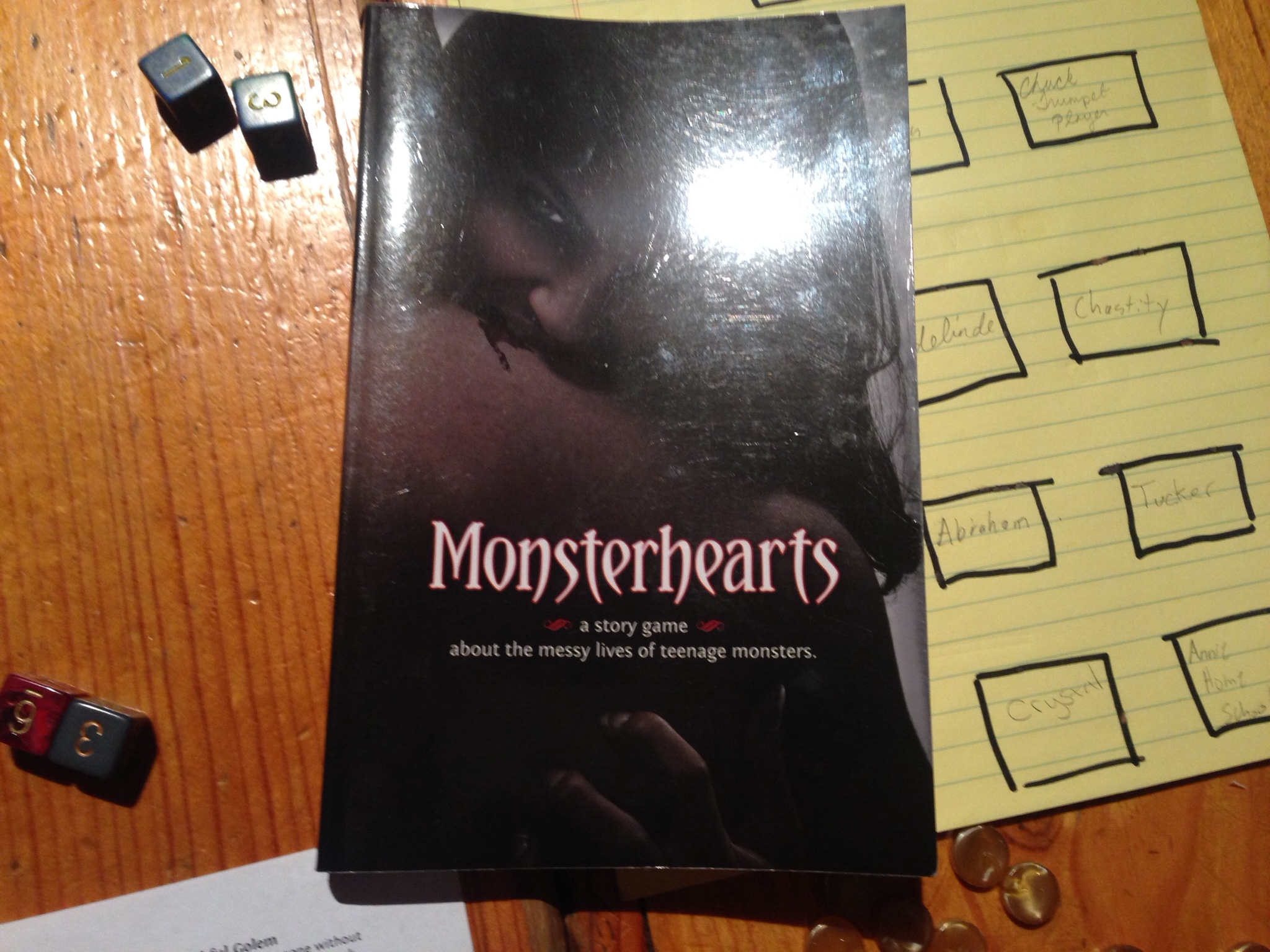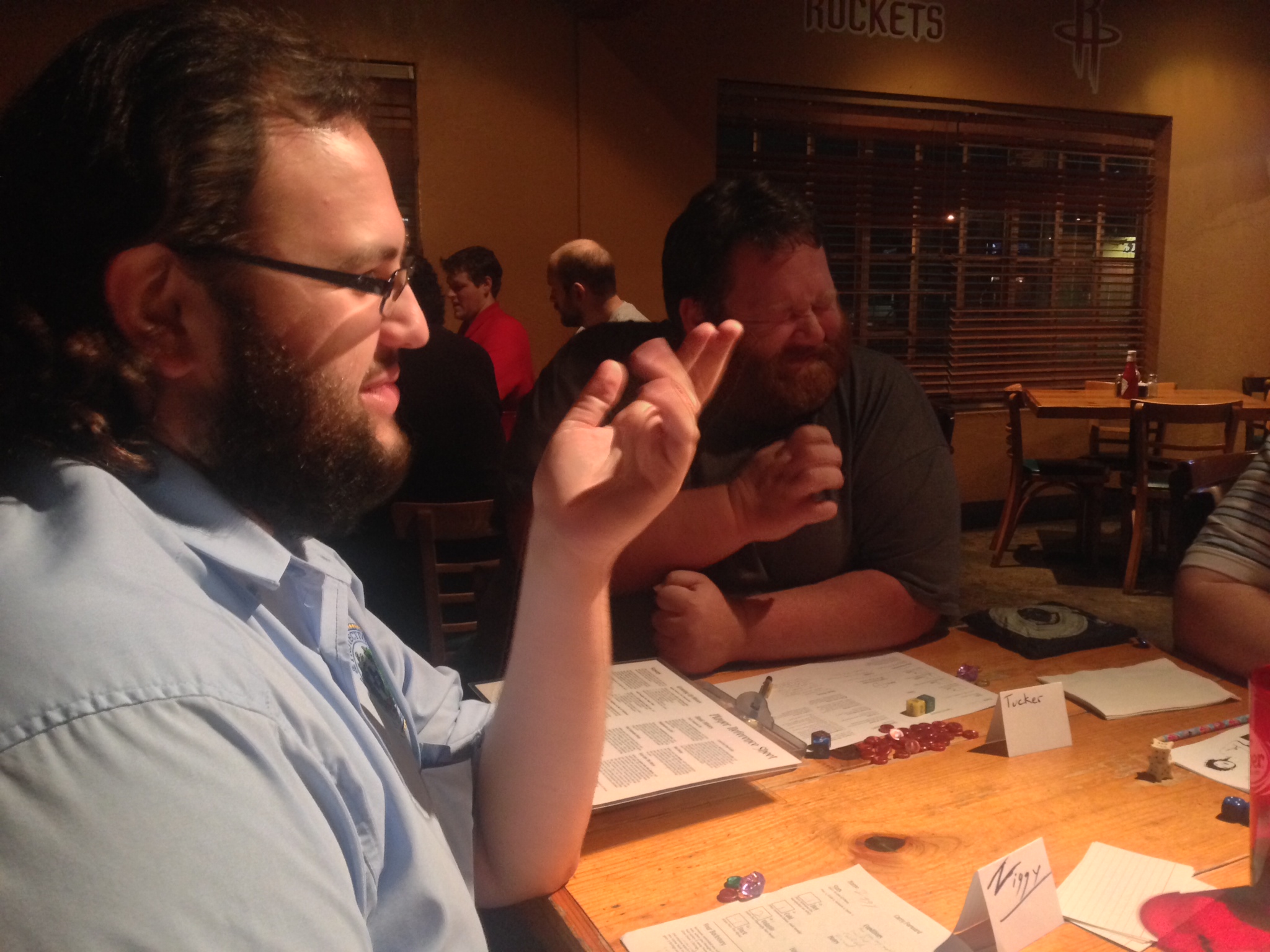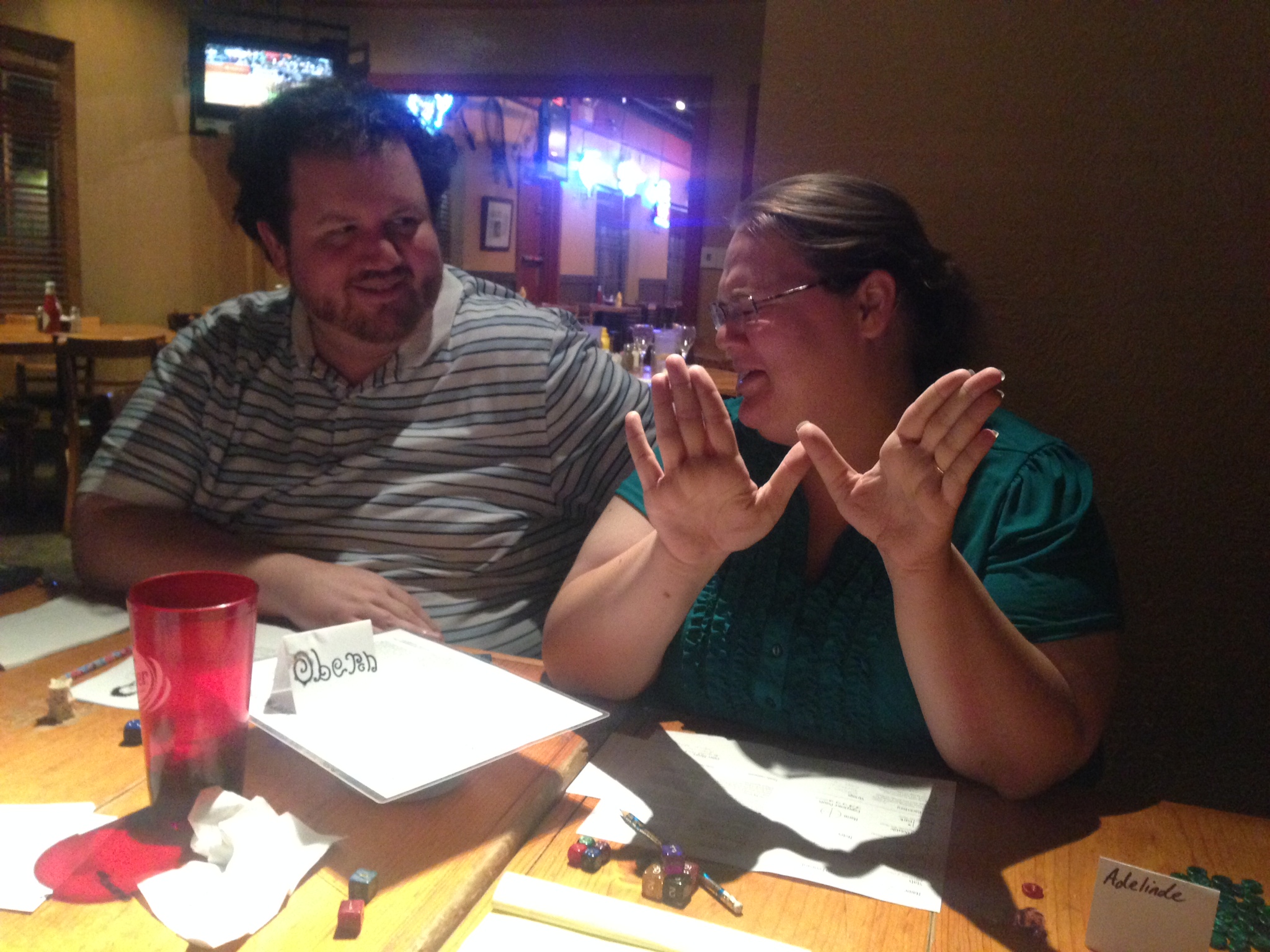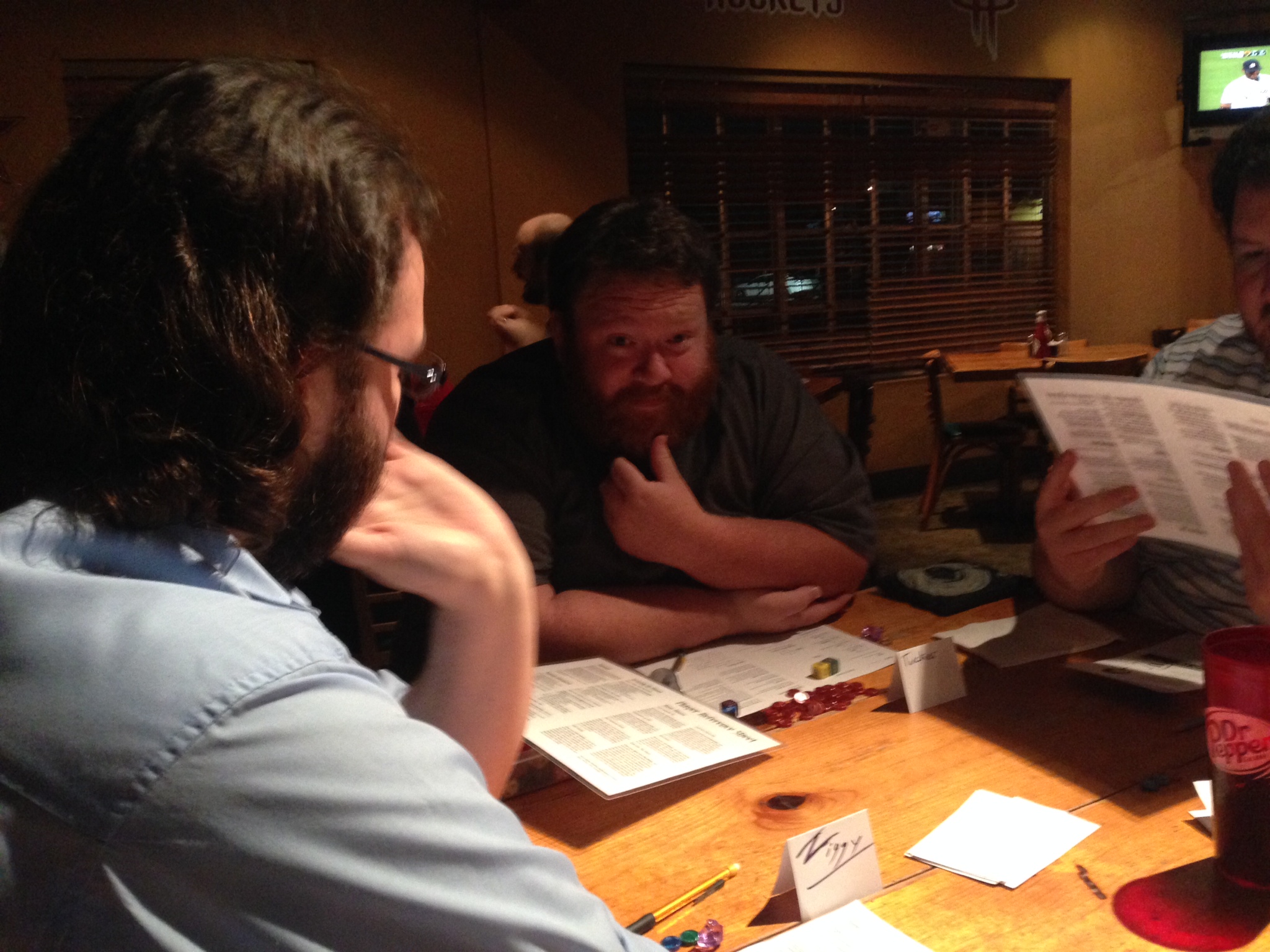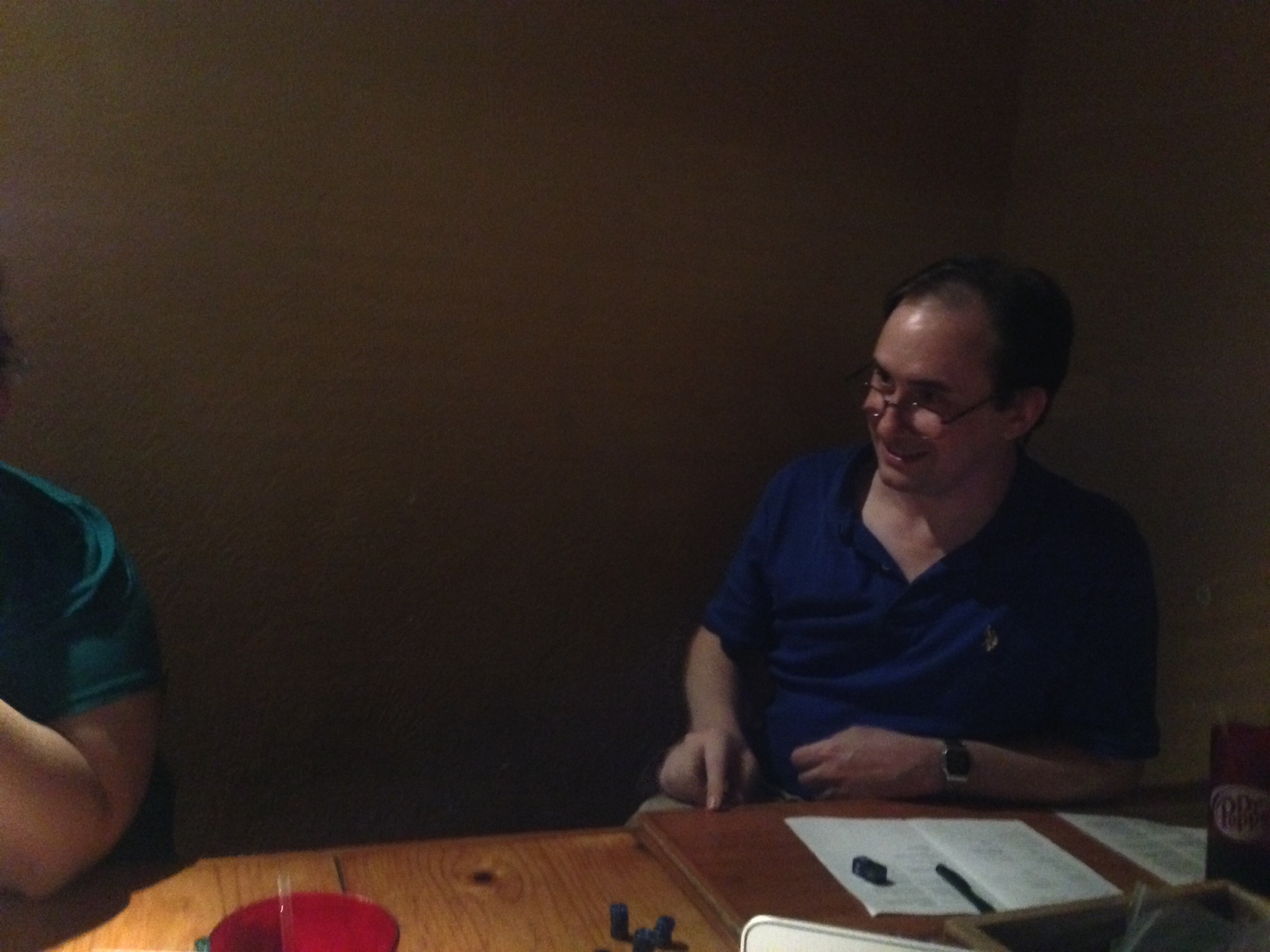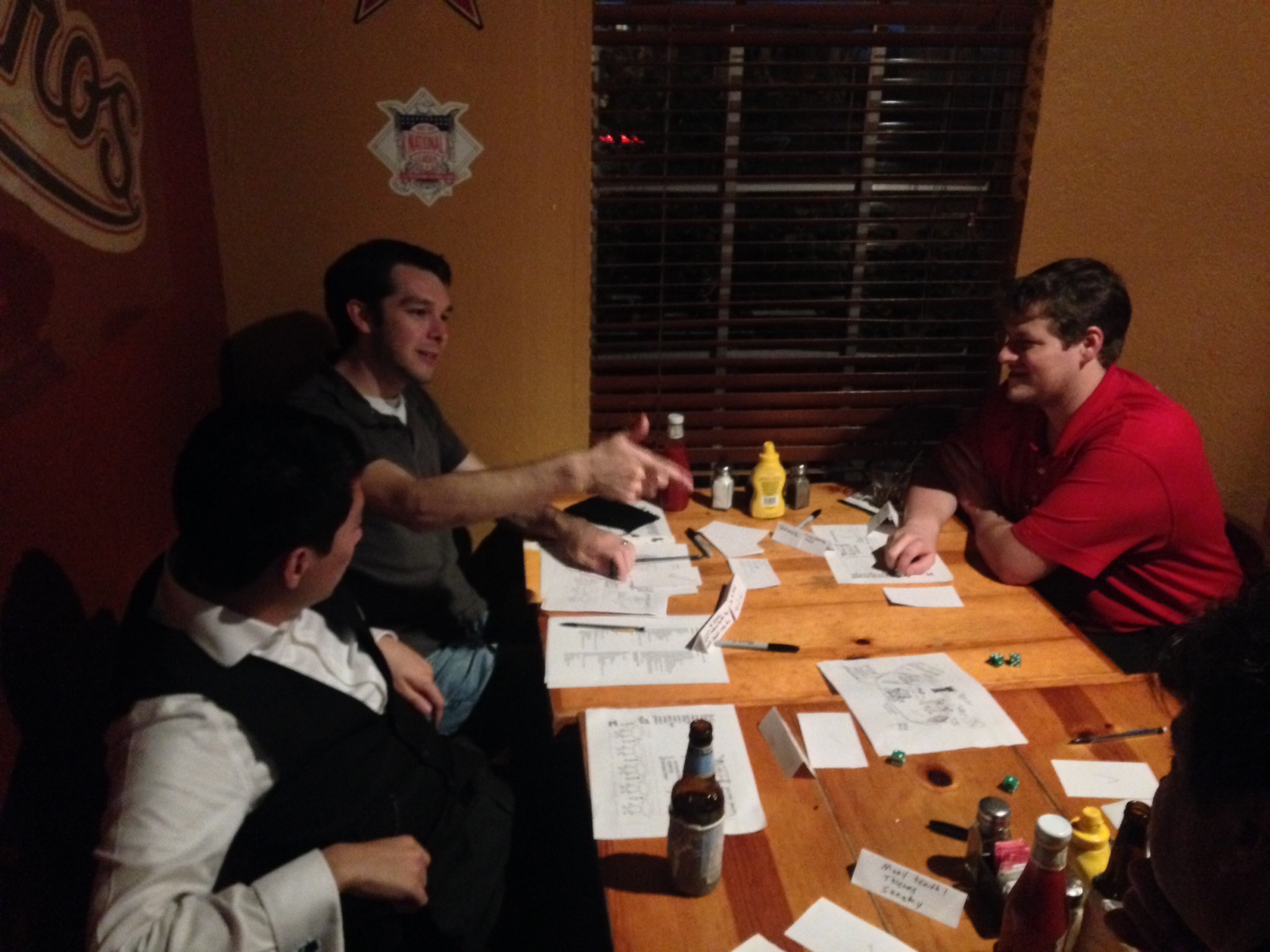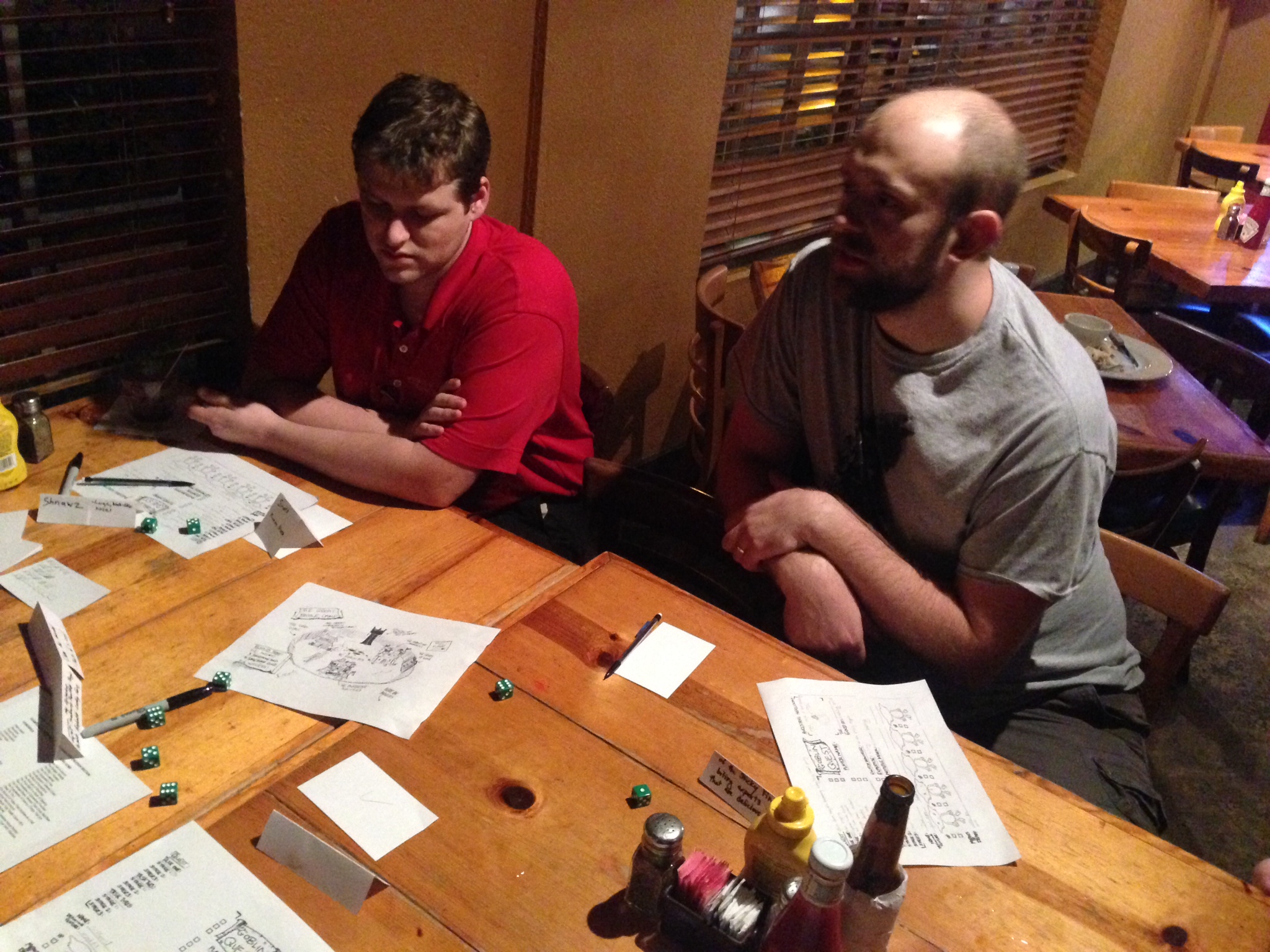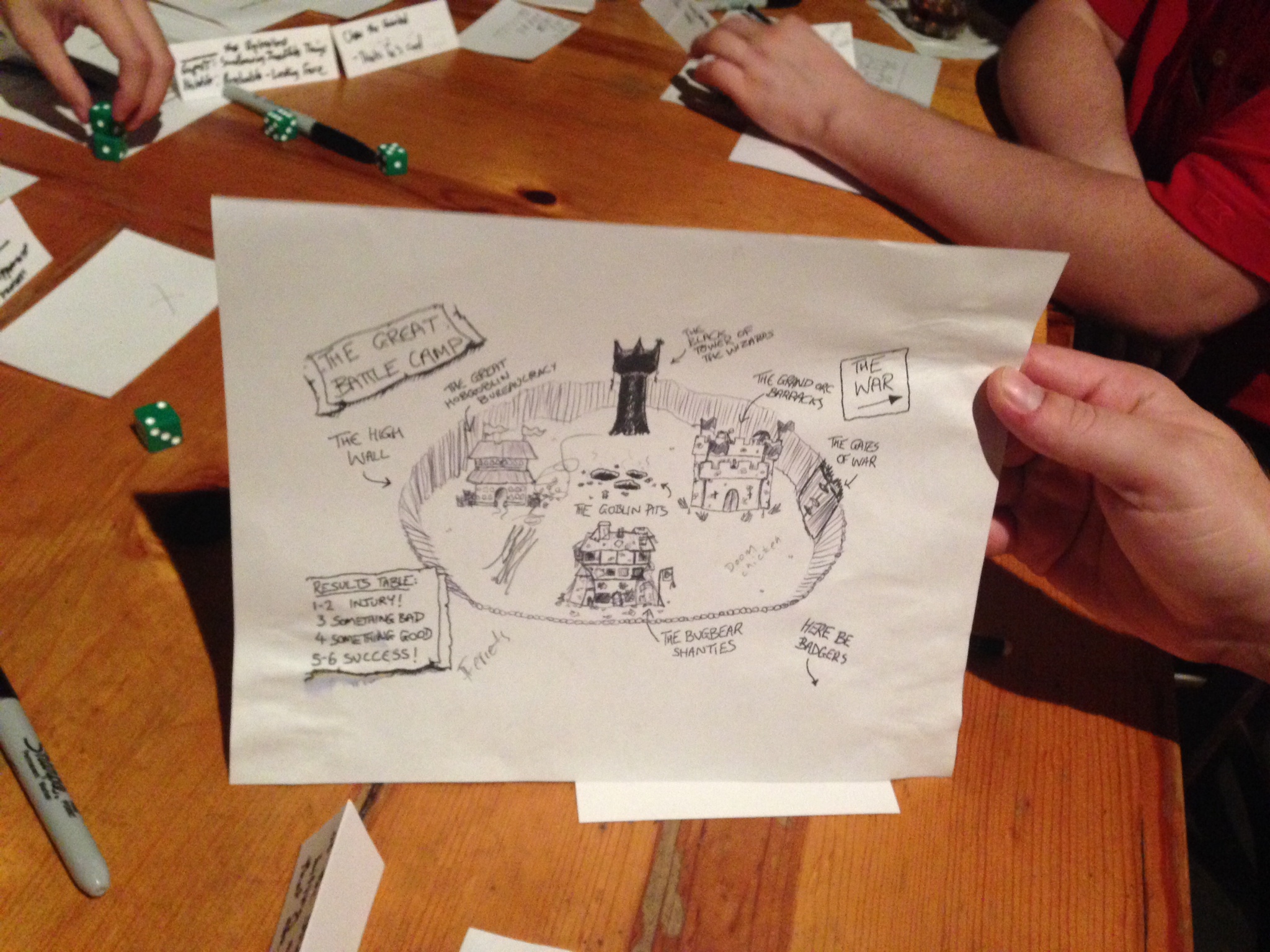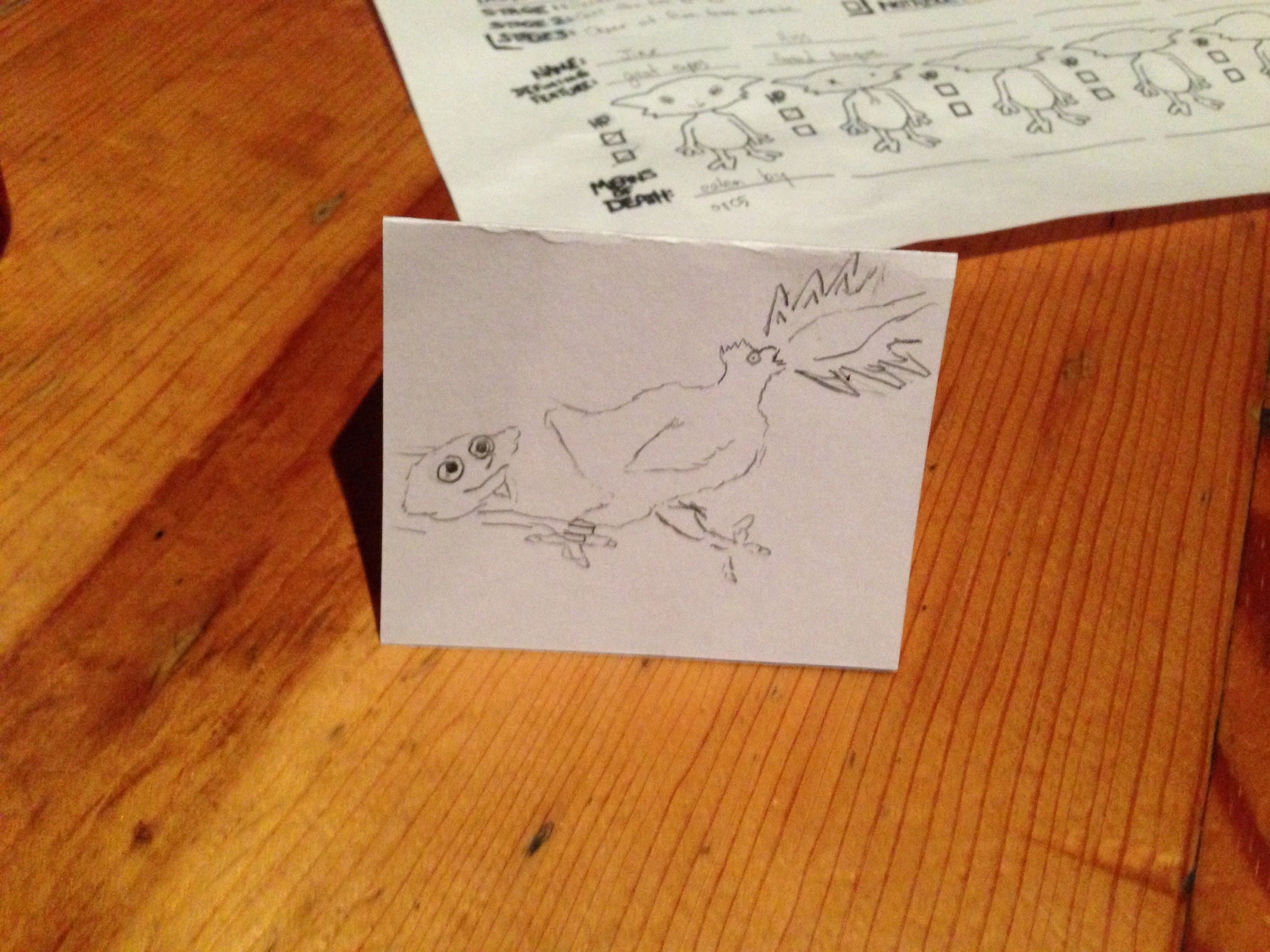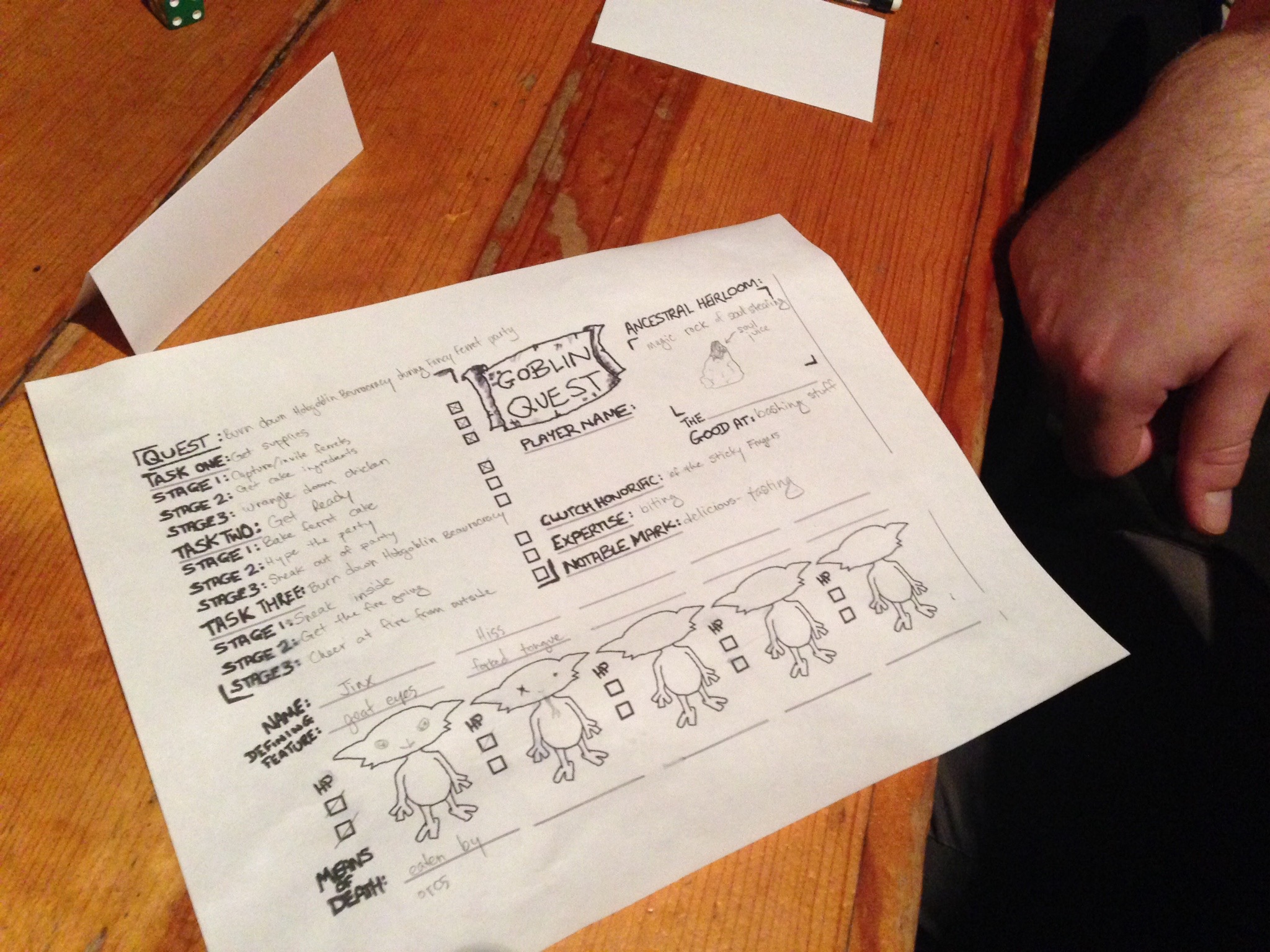Some pics from Dungeon World last night. We had a big group, so we ended up doing two tables.
Thanks to Ferrell Riley for running the other table, and to everyone else for coming out!
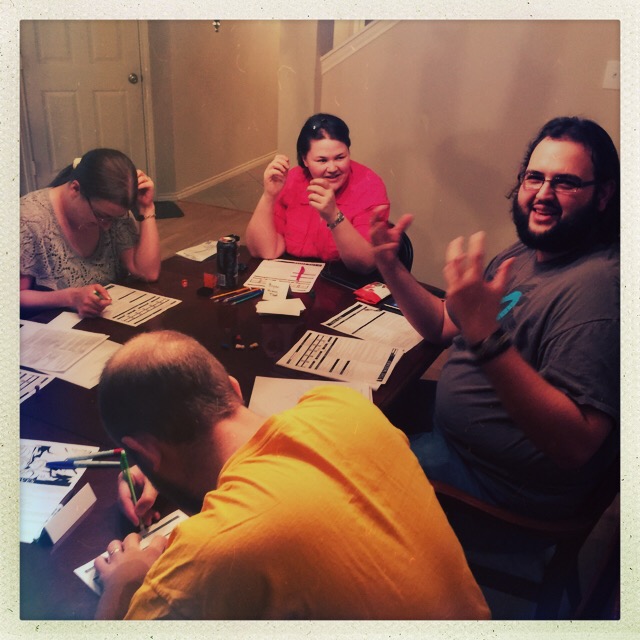
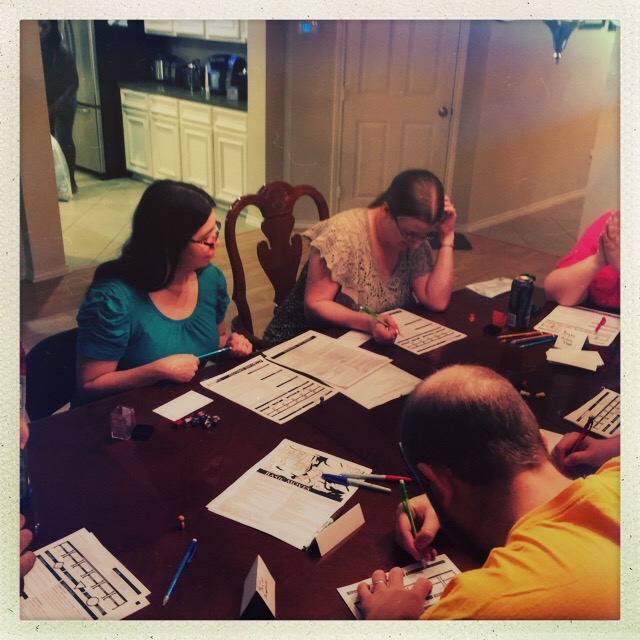

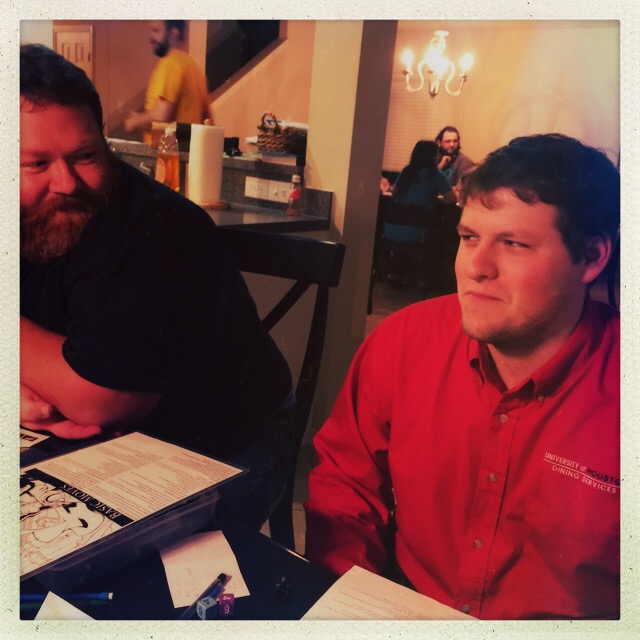
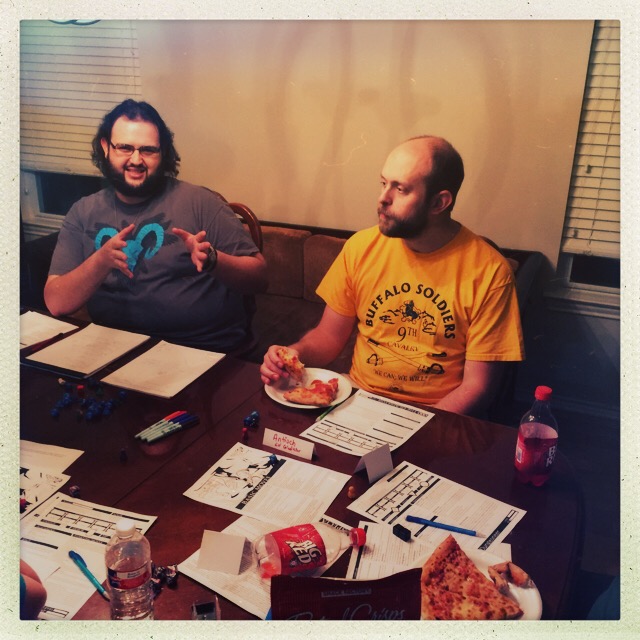
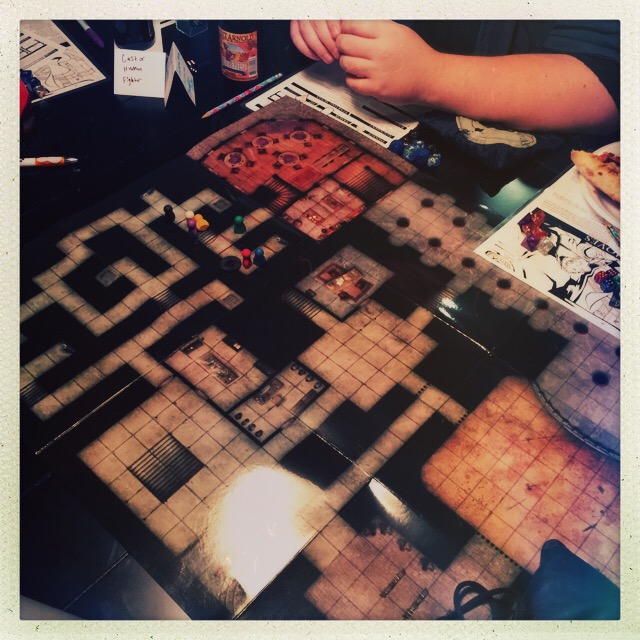
Google+ community from Dec 2012 to March 2019
Some pics from Dungeon World last night. We had a big group, so we ended up doing two tables.
Some pics from Dungeon World last night. We had a big group, so we ended up doing two tables.
Thanks to Ferrell Riley for running the other table, and to everyone else for coming out!






Some pics from Wednesday One-Shots and Board Game Thursday.
Some pics from Wednesday One-Shots and Board Game Thursday. For Wednesday, we played 44: A Game of Automatic Fear and The Final Girl.
44 was pretty awesome. It had a nice vibe; its 1950’s setting came to life in a good way. It is basically Invasion of the Body Snatchers, and that sense of paranoia mixed with tropes from the 1950’s was pretty enjoyable. The rules were a bit finicky, but nothing that got in the way of telling a good story. I’d play it again.
For Thursday, we continued the Pathfinder Adventure Card Game, but also slipped in a samurai game based off Bang! and a few rounds with Machine of Death.
Thanks to everyone who came out: Daniel Lewis Russell Benner David LaFreniere Kristen D Scott Owen Ferrell Riley Gary Wilson and Daniel Fowler.

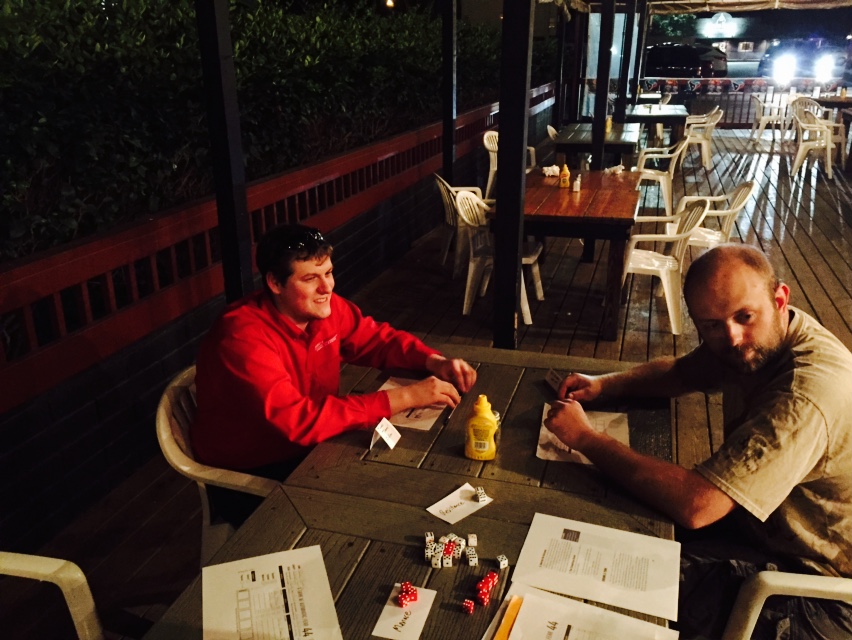

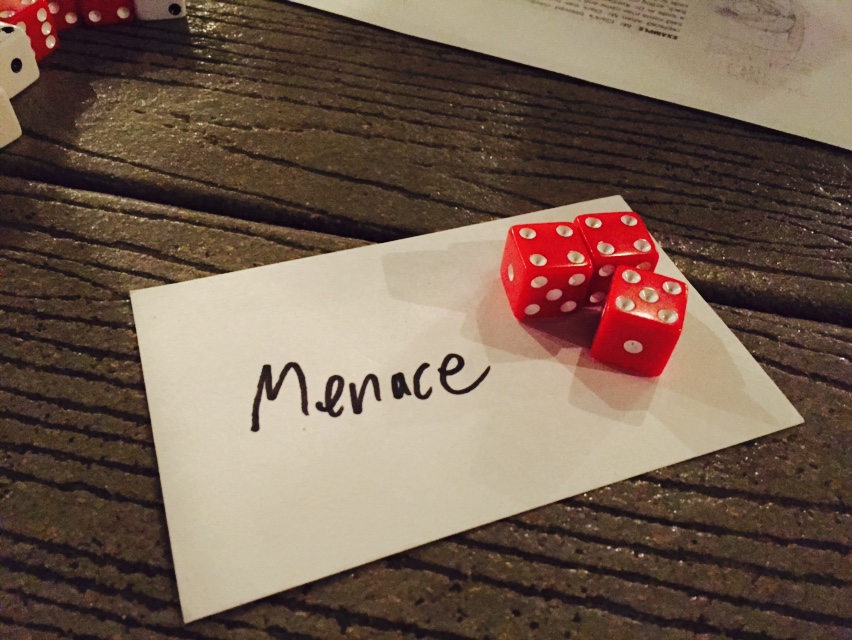
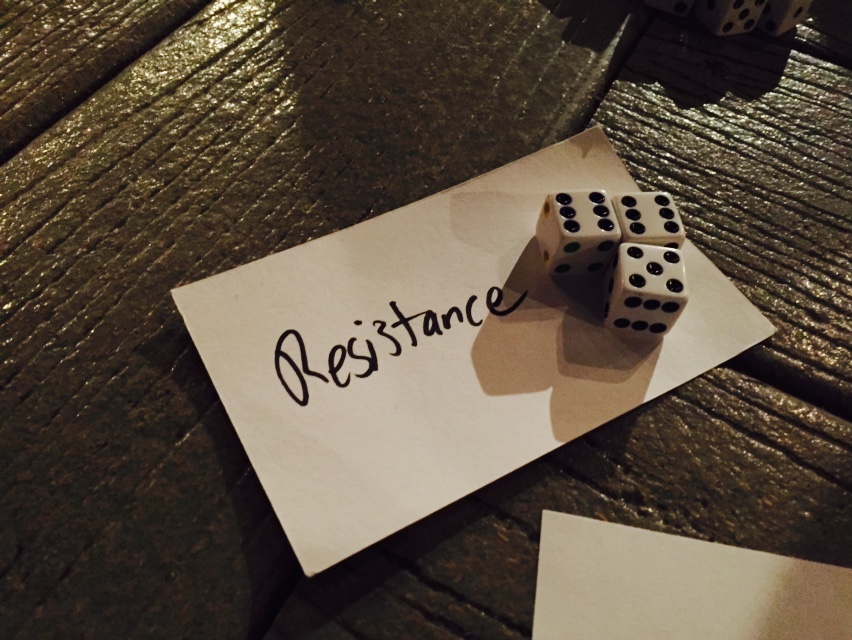
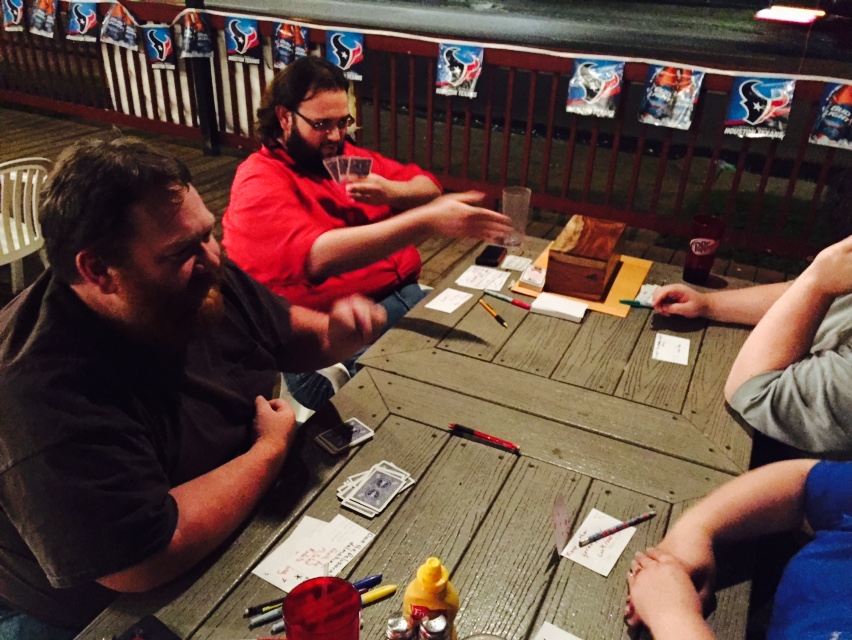
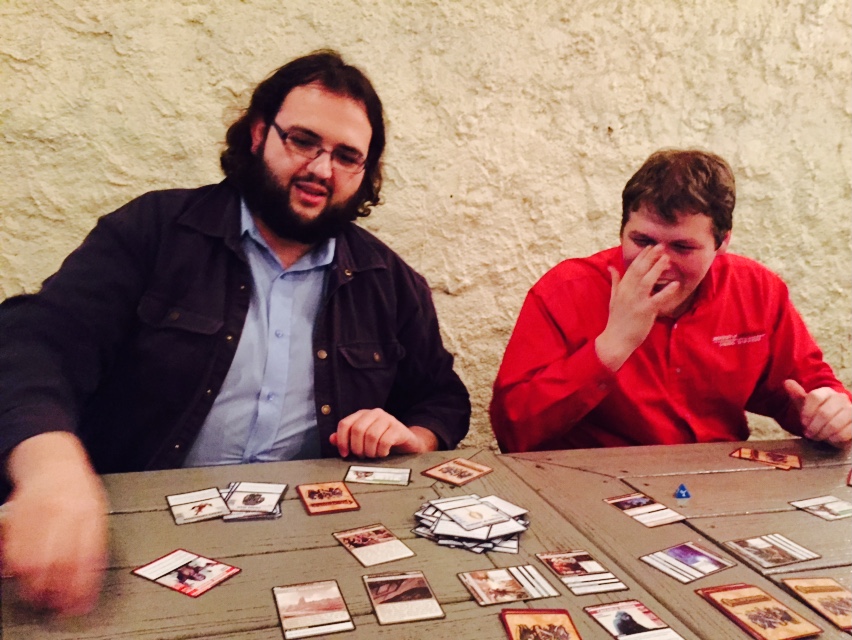
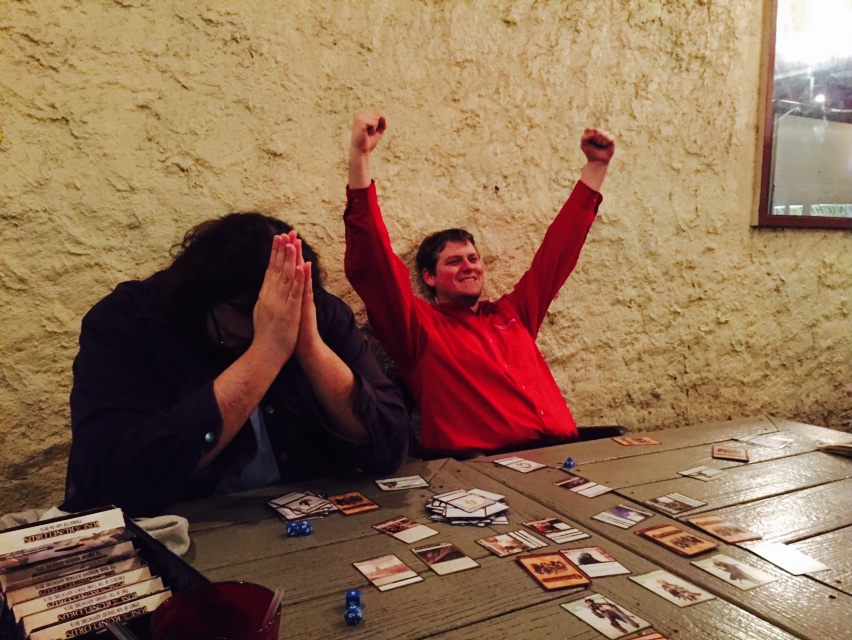
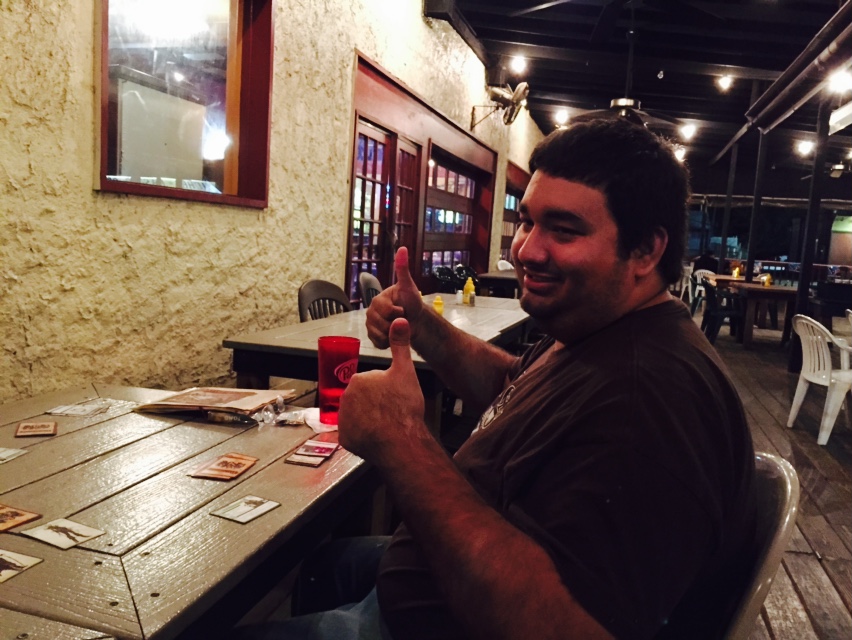
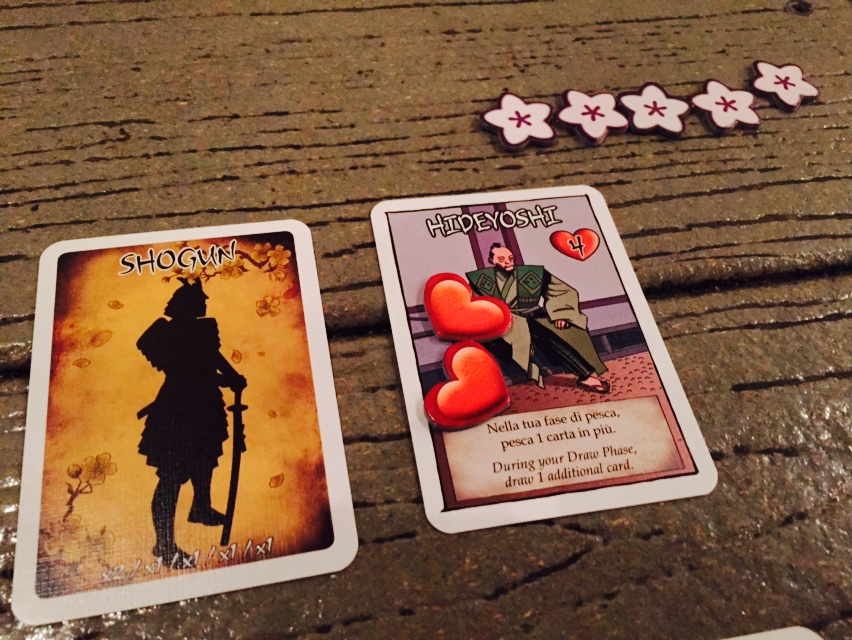
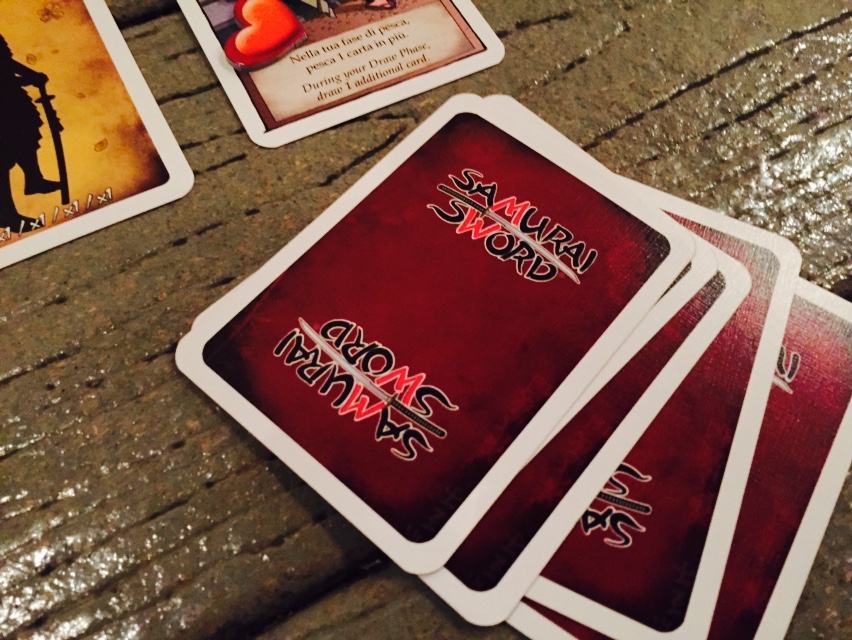
The Hall of Legends #006 – Weekend Warriors

The Hall of Legends #006 – Weekend Warriors
Date: September 12th, 2014; September 13th, 2014; and September 14th, 2014.
Game: Dungeon World
Players: Ferrell Riley Kyle McCauley Jeff Burke Kristina Vansickle Daniel Fowler and Gary Wilson
I’ve been playing roleplaying games since I was in the 6th grade. I often wonder how that changes my perception of them vis a vis someone who came to the hobby as an adult. In many ways, I imagine our experience is not so different; people seem to instinctively understand the joy of group storytelling. But there is something you get as a kid gamer that is very difficult to replicate as an adult: the weekend-long, gaming sleepover.
From the 6th grade until I graduated high school, I participated in regular, weekend-long sleepovers in which my friends and I rolled dice and battled monsters late into the night. We’d play until 6 AM, fall asleep surrounded by books and dice, and then get-up a few hours later and do it again. I can’t count the number of times my nerdy friends and I would be sitting around the table, eating pancakes, arguing about the relative merits of the various 3rd-level Wizard spells (because, let’s face it, the Wizard sucked until he hit Level 5 and could take those sweet 3rd-level spells).
I have many distinct memories from this time, such as when the Tome of Magic came out and we spent a whole Saturday having our minds blown by all the amazing new options that lay in front of us (Wild Magic? Insane! Elemental Magic? Incredible! It was a heady time, I assure you). It was during these weekend sleepovers, probably around the 8th grade, that I created Gormakir the Cruel, a villain who remains a favorite of mine to this day (many of you will know the permutation of him that showed-up in Carcosa), and Cenduwain, the untouchable elf queen powerbroker in ALL my fantasy campaigns. To this day, my friends from that era occasionally ping me on Facebook and reminisce about those awesome times.
Adulthood robs us of this sort of thing, doesn’t it?
Which is why I was so excited about our recent Anthology Weekend. The idea was that we would play the same game of Dungeon World for an entire weekend. While we wouldn’t be able to play until dawn each day, and there was certainly no sleeping over, it was still great fun, and a close approximation of what it was like to game in junior high. For a single weekend, I was reminded of what it was like to have nothing to do but play roleplaying games, and it was kind of amazing.
And what an adventure it was! I’ve been promising a re-cap of the Anthology Weekend game, and this seems like as good a place as any.
Our party consisted of Gerda, the Dwarf Priestess (full title: Gerda Who Holds Fast to the Stone); Heiron the Human, the Human Fighter (his nickname, “the Human,” was given to him by the dwarfs of Gerda’s order, who raised him); Ariel, the Human Elementalist; Hycora, the Elf Druid; Greguh, the Orc Dungeoneer; and Xeno, the Human Mask Mage. They were on their way to the Castle on Dancing Peak, a long-abandoned (and routinely forgotten) keep deep in the Twisting Wood.
After battling a group of orcs who were after the blood-traitor, Greguh, the party arrived at the tiny village of Turning Knot, just outside the Twisting Wood. While investigating the nature of the castle in the wood, they learned, quite by accident, that this particular village had made an enemy in the god served by Gerda, the Sentinel (full name: The Sentinel of the Last Bastion of Day’s Final Night). Owing to the god’s wrath, combined with an angry, vindictive earth spirit inadvertently summoned by Ariel, the village of Turning Knot found itself swallowed by a crevasse. The party managed to escape the catastrophe relatively unscathed, but were no closer to learning the secret of the Castle on Dancing Peak, and had to get a move-on as there were orcs on their tail.
They set out into the Twisting Wood, a journey which took almost a week, as that particular forest is notoriously difficult to navigate, and came upon the ruins of a shrine to St. Abren, who, in life, tried to map the great forest. After narrowly escaping death at the hands (hoofs?) of a family of minotaurs who had made the ruins their home – and after recovering a trio of life-renewing bottled fairies hidden there – the party continued their journey.
The castle stood on a high, twisting peak (a “dancing” peak, if you will) freestanding in the middle of a deep valley. It was connected to the edge of the forest by a long bridge, which itself was a structure that had both an inner passage in addition to the topside crossing. The party trekked across the bridge, fighting off skeletons and manticores. In what has become my moral quandary equivalent of the infant goblins in Keep on the Borderlands, the party found a baby manticore and had to decide whether to kill it or let it live (they killed it, of course, just like every other party who has encountered a baby manticore in my DW games). They went inside the bridge, too, which was filled with numerous deadly traps. There they found a shrine to the evil rat god, Reekeesik. Behind the shrine’s altar, they discovered a little black door, carved with images of rat swarms, no more than three feet high. The door appeared to lead nowhere (it simply opened to a brick wall) but the party deduced that this door was used to travel to the 434th layer of the Abyss, the home of the rat god himself! Gerda’s god commanded her to find a way into that realm and slay Reekeesik. They didn’t know HOW to use the door, but they figured the answer would be somewhere in the castle.
The rest of the adventure principally revolved around searching the castle, discovering its secrets, and finding a way to destroy Reekeesik. During their search, they learned the castle was actually called the Castle of the Dreaming Doors, and that, in fact, there were numerous little doors all over the place, each leading to a different realm in the Outer Planes. They learned that one could only enter the doors during astral projection.
After discovering a secret tomb on the side of the castle, the entrance to which hung freely in open space (with a long fall into the valley beneath it) the party learned the castle belonged to the legendary Castafiel family. The Castafiels, it seemed, were religious crusaders who conducted raids into the evil outer planes and recovered from battle in the good outer planes. This strange castle, with its little dreaming doors, was the base from which they launched their raids.
The party encountered numerous monsters, including my infamous gelatinous cube trap, but their principle nemeses while searching the castle were the Flower Knights; ancient, wandering warriors bound to the Castle for eternity by powerful magicks. The Flower Knights were: the Knight of Mums, loquacious and eccentric; the Knight of Orchids, utterly insane and longing to be reunited with “mother”; and the Knight of Silver Lillies, who guarded the castle in its form on the astral plane. The party managed to defeat the Knight of Mums and the Knight of Orchids, but reached detente with the Knight of Silver Lillies, who refrained from attacking them so long as they didn’t bring anything evil into the castle from the Outer Planes.
Ultimately, the party discovered the plans being made by Lucero Castafiel to destroy Reekessik. Though Lucero didn’t live long enough to carry out the attack, he did craft a weapon, the Rat Stabber, forged from Olympian steel and the bone of a great owl belonging to the goddess Athena, which was to be used to destroy the demon rat. They found this weapon buried with Lucero in the Castafiel crypts and then made their way to the Dreaming Room, where special incense would put them to sleep and project them into the astral plane.
The conclusion was positively epic. The party entered the 434th layer of the Abyss, which was all inky blackness, and navigated their way to Reekeesik’s pit using Lucero Castafiel’s map (after destroying a few of Reekesik’s demonic minions, that is). The demon god’s lair was pulsating with millions of rats, which the party had to wade through before reaching him. The beast, a gigantic rat with thirteen legs, three mouths, and ten eyes, rose to meet them. Some members of the party were too scared to continue. Others were frightened, but steadfast. Gerda, believing she was answering a divine call, ran to a ledge and jumped, attempting to pierce Reekeesik’s heart with the Rat Stabber (which was a sort of javelin). Unfortunately, she failed and was swallowed by the rat god. But her loyal follower, Heiron, took up the weapon and plunged it deep into the beast, slaying it.
Gerda passed beyond the Black Gate, to the realm of her god, the Sentinel, who explained that her divine mission was to raise-up Heiron and lead him to Reekeesik. She then began her eternal watch on the Sentinel’s tower. There were lots of other cool details during the course of the adventure I don’t have time to mention (search the Anthology folder for The Irresistible Mule – you won’t regret it), but suffice to say, it was an amazing weekend.
I’ll conclude very quickly with something that occurred to me while I was writing this: the Gauntlet is entirely about recapturing that feeling of what it was like to game in junior high. The Anthology Weekend was the most immediate evidence of this, but I think, deep-down, all my efforts with this group are a love letter to my childhood.
But it’s more than that, too; more than mere nostalgia. It’s passion. It’s a self-sustaining energy loop, giving back two-fold what I put in. It’s like the character Max Fischer from the movie Rushmore: “I guess you’ve just gotta find something you love to do and then do it for the rest of your life.”
Maintaining a Good Pace in Dungeon World
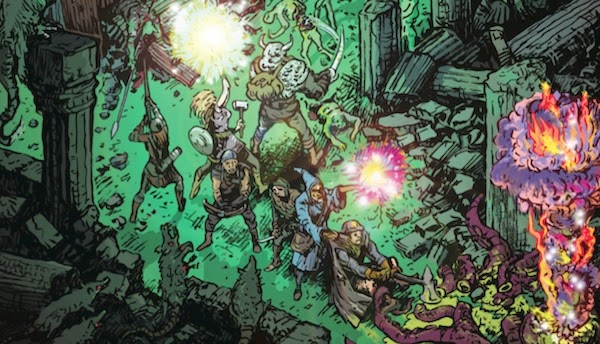
Maintaining a Good Pace in Dungeon World
Everyone has strengths. Your strength may be math or music. Perhaps your strength is sports. My strength is running a well-paced roleplaying game.
Dungeon World is a terrific game because, among other things, its rules encourage a good flow around the table. But it’s not automatic. The key to running Dungeon World successfully is understanding how the moves intersect with and flow into each other. Below are some tips for maintaining a dangerous and exciting game of Dungeon World. Please note: some of these tips can be applied to any roleplaying game, and if you are a trad GM, you definitely need to read this, because your game probably suffers from pacing issues.
Tip #1: Defy Danger keeps your game well-paced. In games I run, I’d say fully half the die rolls are Defy Danger. It is, essentially, a universal move. It’s what you have the players roll when you’re not sure what other move got triggered by their narration.
The important thing here is how you use it, which is to say you should always use the 7-9 and Miss results as an invitation to immediately follow-up with more action. So, for example, let’s say the Thief is trying to roll away from a monster’s blow. You have him roll Defy Danger +DEX (naturally). He gets a 7-9, and so you follow-up by putting his weapon in danger: “You roll out of the way, but your bow slipped off your shoulder and is now hanging precariously off the edge of a cliff!” You then follow-up with the Fighter: “Hey, his bow is about to fall off the cliff. What do you do?” If he ignores it, the bow is gone. If he doesn’t, use another Defy Danger (the bow is in danger, after all). If they get another 7-9 (or, depending on the circumstances, a Miss), perhaps they recover the bow, but they slip themselves and are now hanging precariously from the edge. That’s when you ask another character: “He’s about to fall off the cliff. What do you do?” And so forth.
Essentially, Defy Danger allows you to create cinematic pacing so long as you are constantly following-up on those 7-9 and Miss results. You don’t ease up until someone gets a 10+ or if they Miss in such a way that it would dramatically alter what’s going on in the story.
Tip #2: Resist the temptation to ask questions generally of the players, such as “What does everyone do?” or “Who wants to deal with Danger X?” It will slow your game down in a huge way. Instead, present the situation and then ask a specific player how his character responds to it. For example, let’s say an ogre bursts into the clearing where the party has made camp. DO NOT say “An ogre has just burst into camp! Who wants to do something about it?” Instead, say “An ogre has just burst into camp! Boros, you’re standing closest to him as he gets ready to swing his club. What do you do?”
Sometimes I think GMs are worried about taking away player agency by presupposing what their character is doing when danger strikes, but trust me: the only players who will quibble with you on this sort of thing are pieces of shit you probably shouldn’t be gaming with anyway. Everyone else will appreciate the chance to have their character shine.
Tip #3: Always, always, ALWAYS start a session in media res. For those of you who don’t know, in media res means “in the middle of the action.” Nothing is more boring than starting a session in the tavern or (shudder) with the characters shopping for supplies. Instead, have the characters surrounded by enemies when the session opens. Have them stabbing and jumping and killing. Put them in immediate danger. If the characters were getting ready to shop for supplies when we left them last session, open the new session with bandits trying to jack the coin they’ve been flashing all over town.
If you don’t want to start with a fight, start the session with the characters trying to hide from guards or break into a safe or negotiate with a crime lord. The key is to have them doing something that is not boring. If you start a session with the characters doing boring shit, your game is in danger of having no momentum. A good analogy here is a James Bond movie. Every James Bond movies starts with a big action scene that gets you pumped up and sets the tone for the entire experience. Do thou likewise with your DW game.
I’ll finish-up with my classic in media res set-up for a brand-new DW campaign, which works beautifully: the party is on their way to Dungeon X when they get jumped by Monsters X. Make it super-dangerous. Limbs, eyeballs, and gear are all fair game. Last Breath is a real possibility (better to lose a character at the outset than in the middle of the adventure). Once the fight with Monsters X is over, have them search the bodies for treasure, which is the cool-down moment. Reward them with a single piece of sweet loot, along with a few coins and gems. Let them have a moment to take stock. Then: do Undertake a Perilous Journey to finish-up the trip to Dungeon X. This will get everyone’s head back in the game and ramp up the danger once again (particularly if the Scout roll goes poorly). A nice side effect is that, if you have new players, you will have basically taught them the whole game with this set-up (Combat, Discern Realities, the abstraction concept, and so forth).
Jason’s Gaming Crate
Jason’s Gaming Crate
We run lots of in-person games; sometimes three or four a week, and sometimes with multiple groups at the same game night. We often have to get a game to the table with little advance notice. Given that, I have found it is helpful to have a collection of multi-purpose gaming aids within easy reach at all times.
My gaming crate contains the following:
-Folders with character sheets and notes for any active campaigns we have going on.
-A multi-pocket file for laminated play aids and character sheets.
-A Pathfinder flipmat.
-My dice bag
-An inner box with pencils, markers, tokens, and note cards (see pictures for details).
-Books and accessories for games we play often (such as Dungeon World and Fiasco).
Combined with an iPad for PDF rulesets, I can run dozens of different roleplaying games out of this crate. Take a look at the photos for more details.
Do you have any suggestions for play aids you like to keep handy? If so, post in the comments.


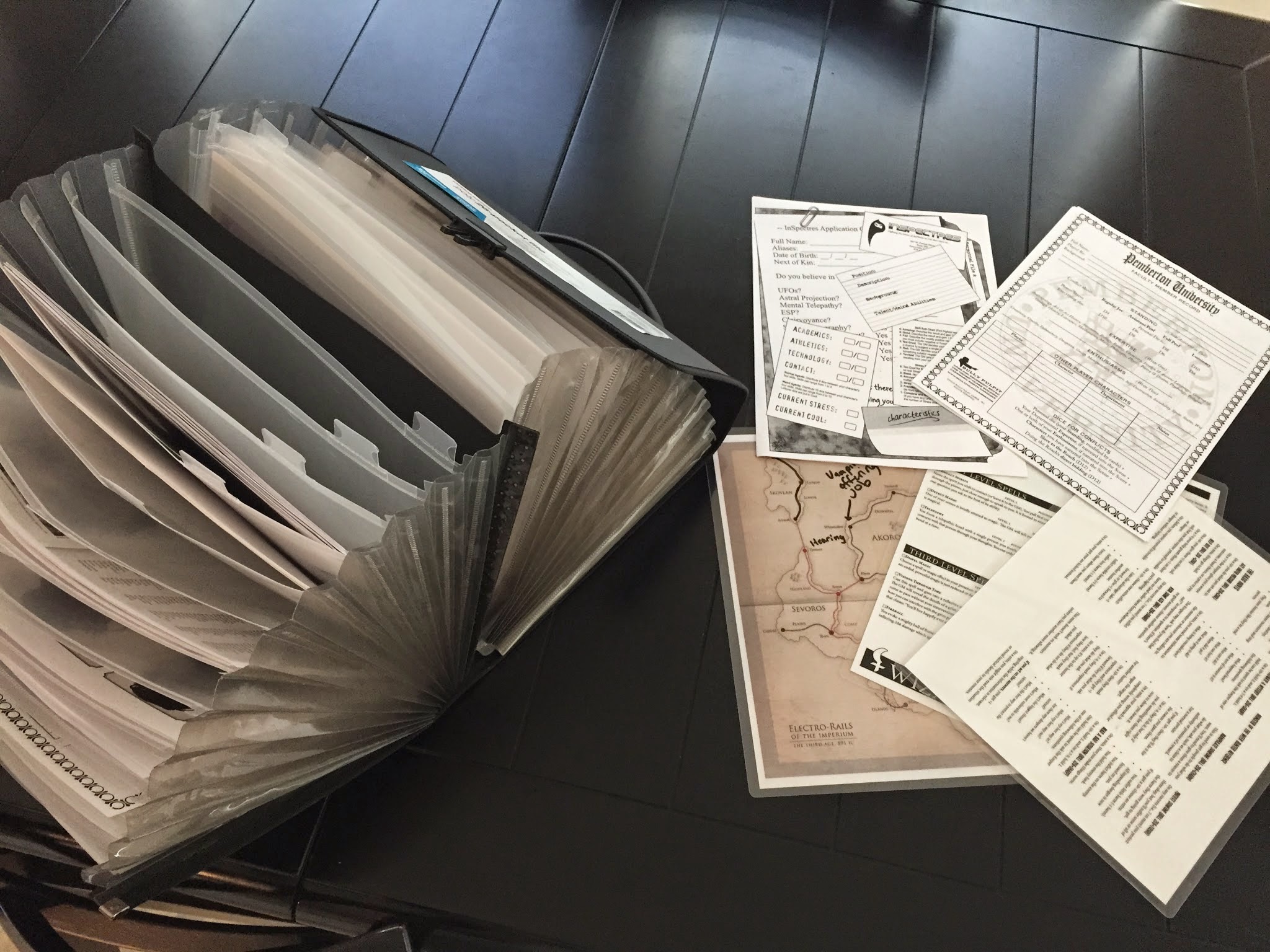

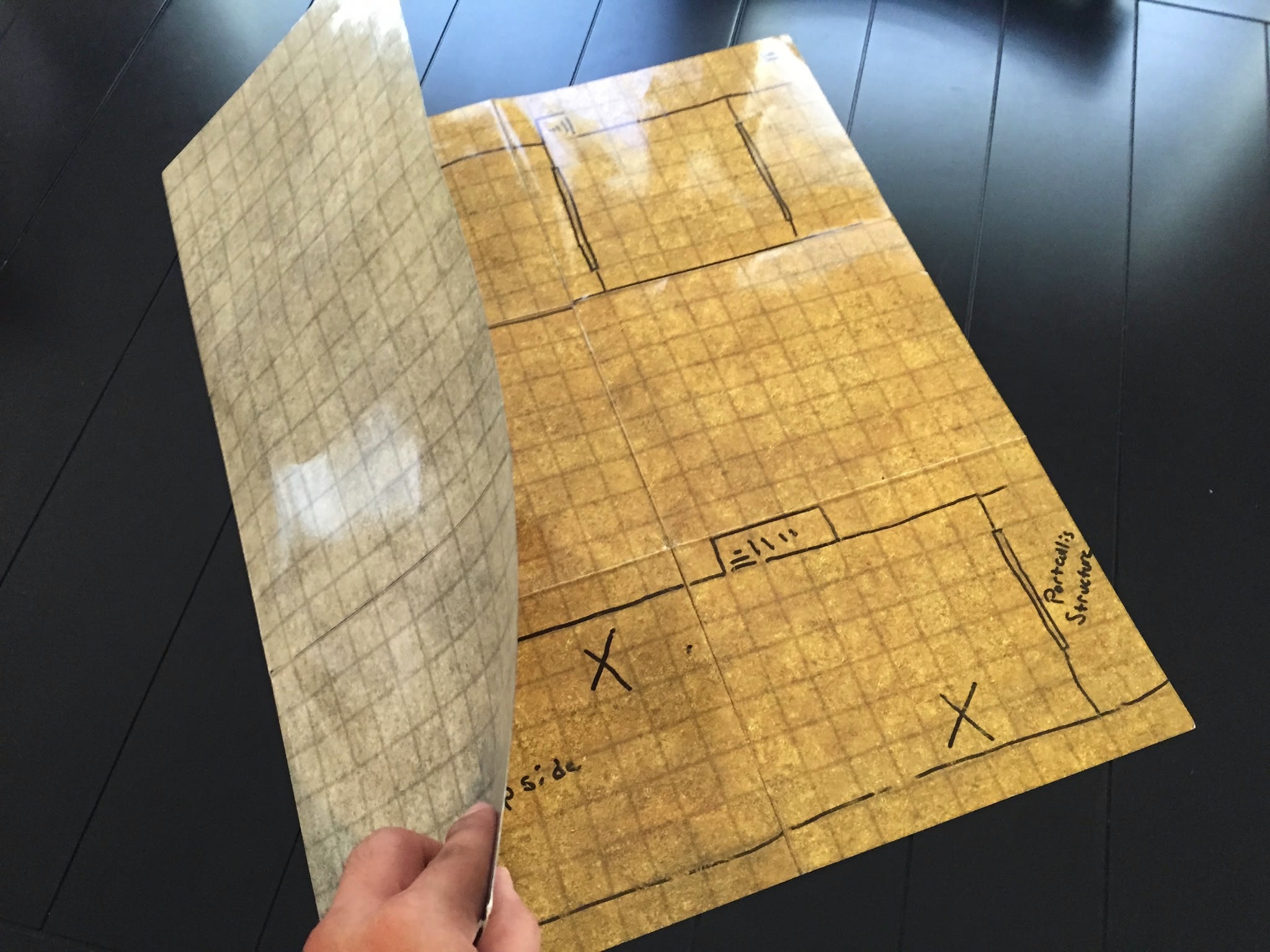

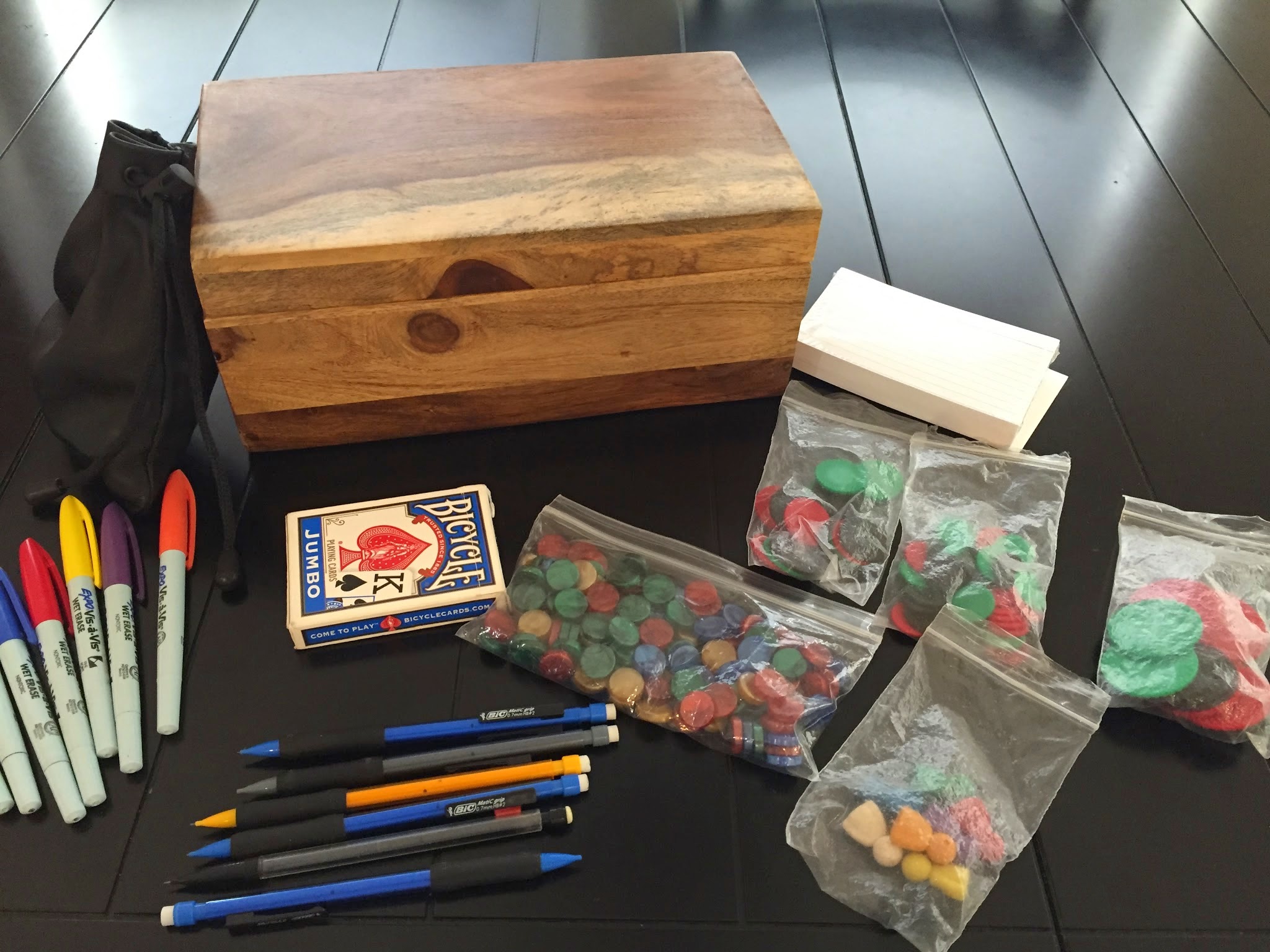

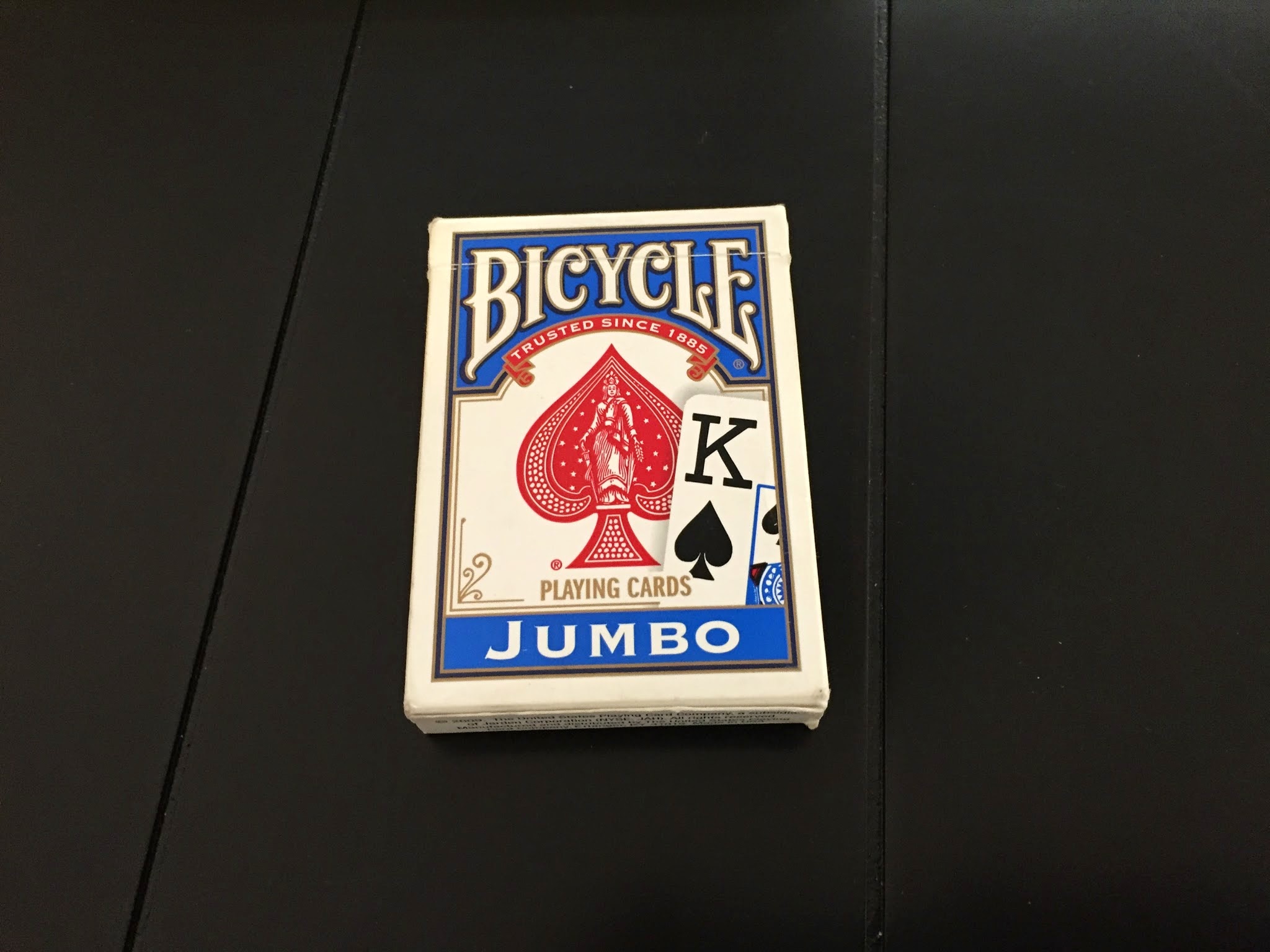

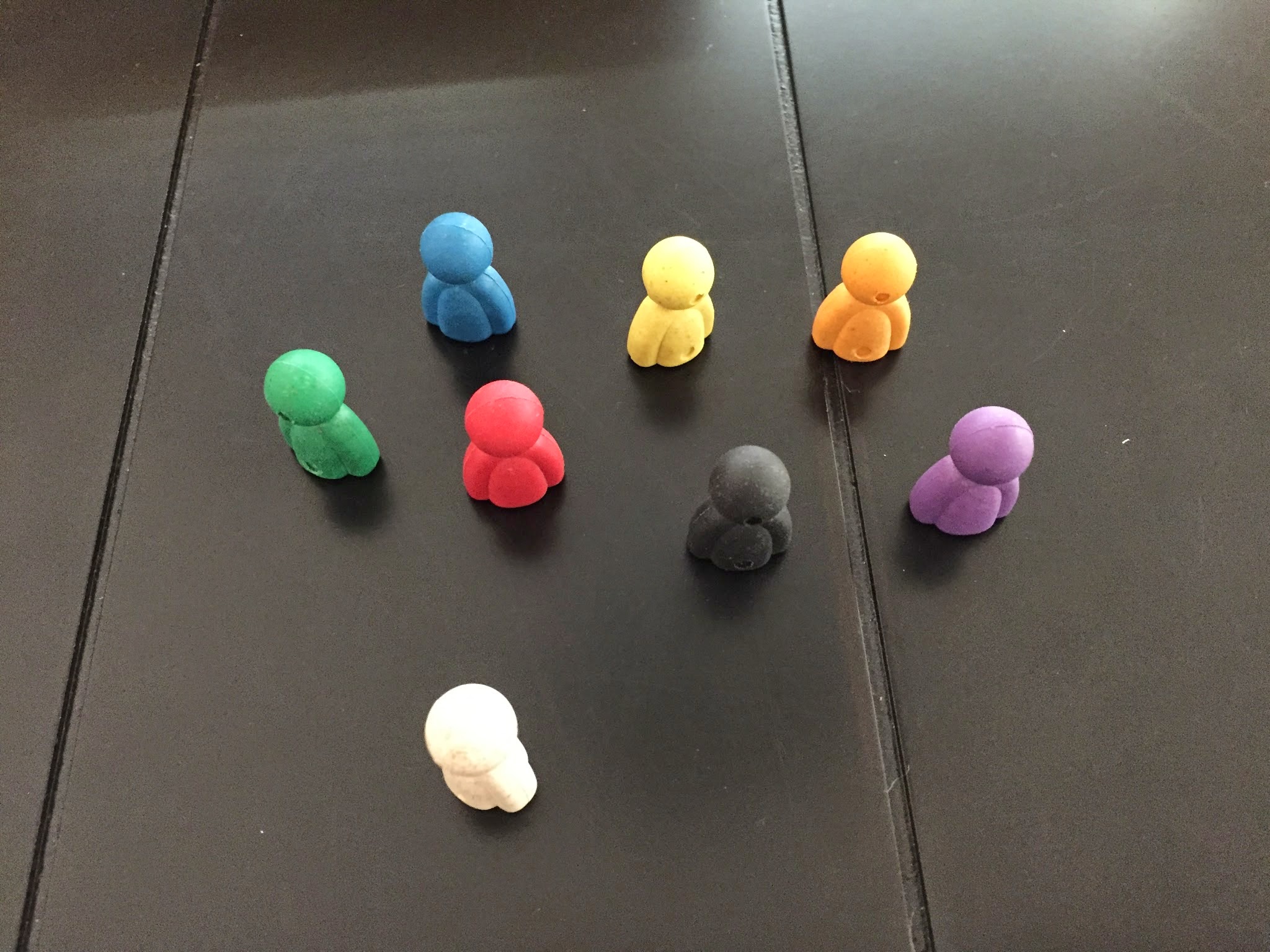
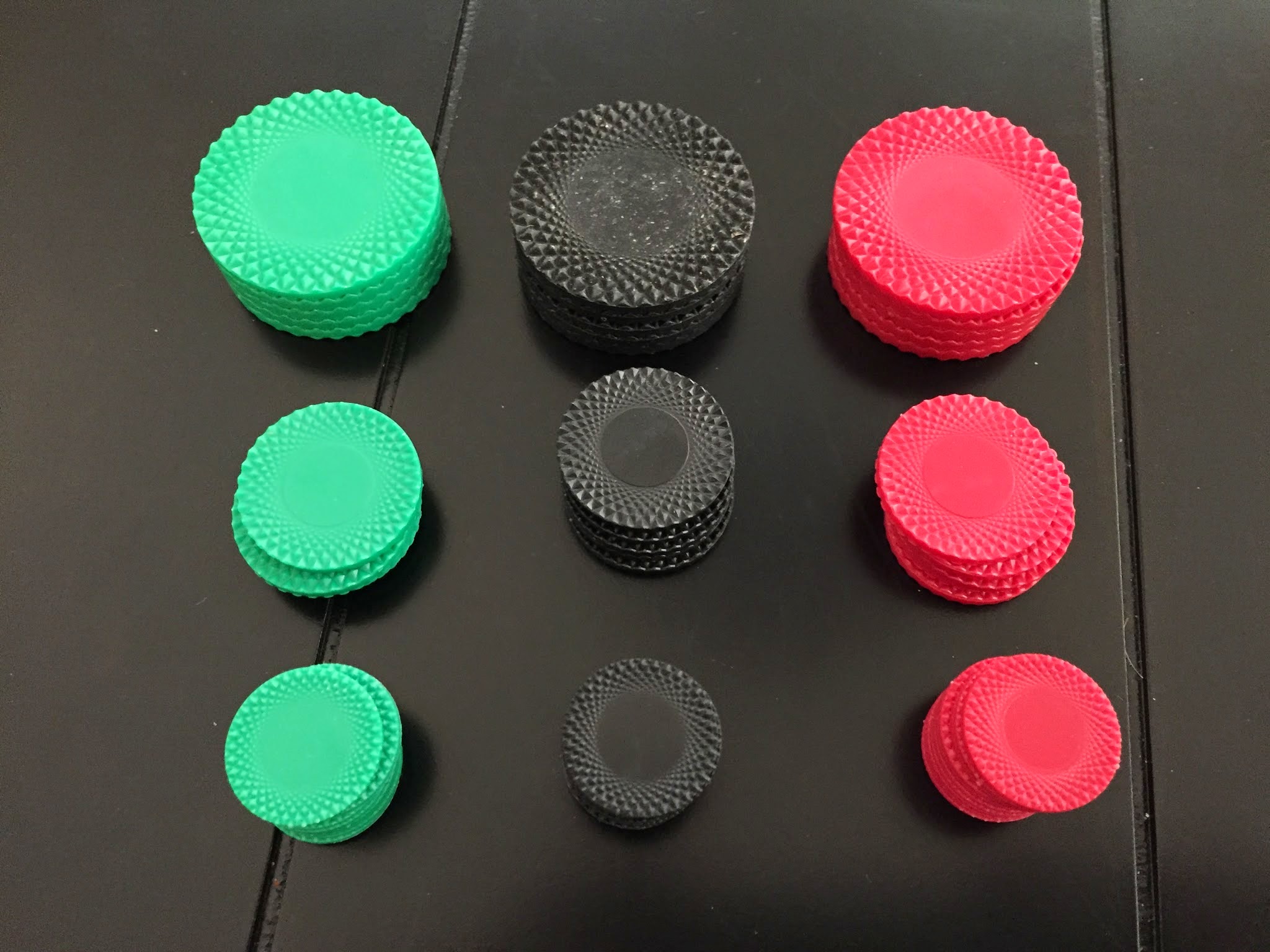
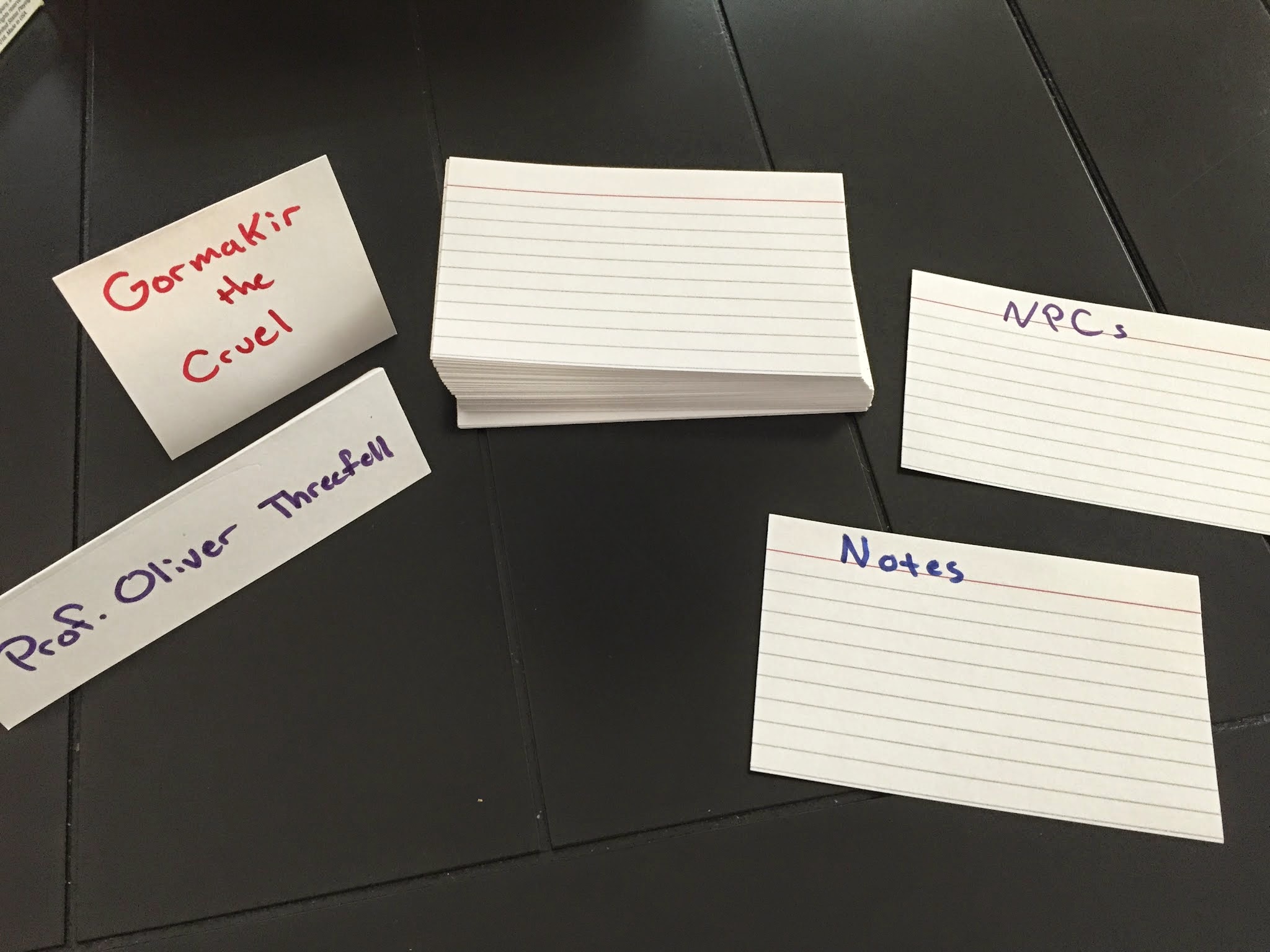

I’m thinking of adding a section to the Community page where we talk about GM resources, as well as give advice and…
I’m thinking of adding a section to the Community page where we talk about GM resources, as well as give advice and tips for how to run/facilitate a good game. Is that something you all think would be helpful?
Some pics from Grey Ranks.
Some pics from Grey Ranks. In this one, you play youthful resisters of the Nazi occupation of Poland during WWII. It is very similar to Misspent Youth in that your characters have to decide whether they sacrifice the things they hold dear in order to resist the big bad.
We had fun, but this game definitely needs to be played for the suggested three sessions. I think we missed out on a lot of meaningful character development playing the truncated version. Also, I think the mechanics would be more salient over the course of the full game. Basically, we didn’t really have time to let the story breathe. I’d love to try it again in multiple sessions.
Thanks to Steve Mains for facilitating and to Ferrell Riley Aaron Scott and Marcus Centurian for coming out.
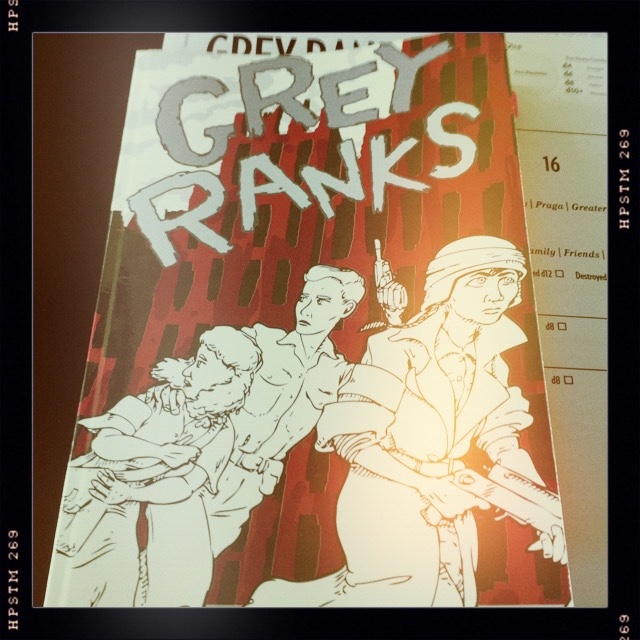
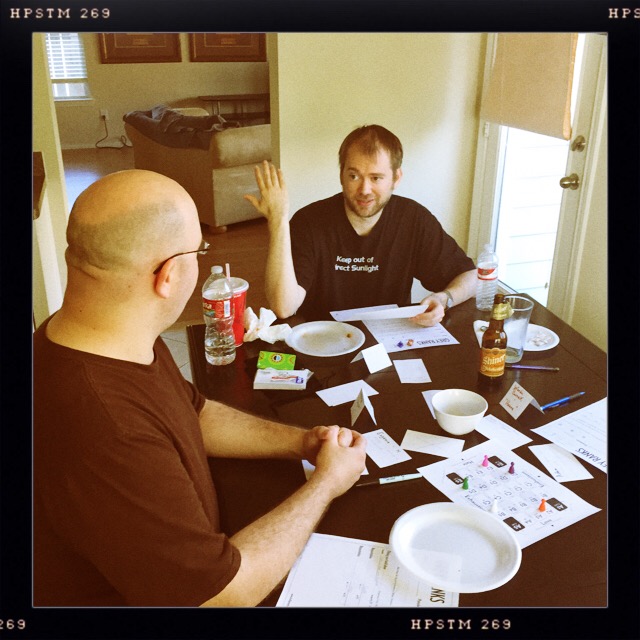
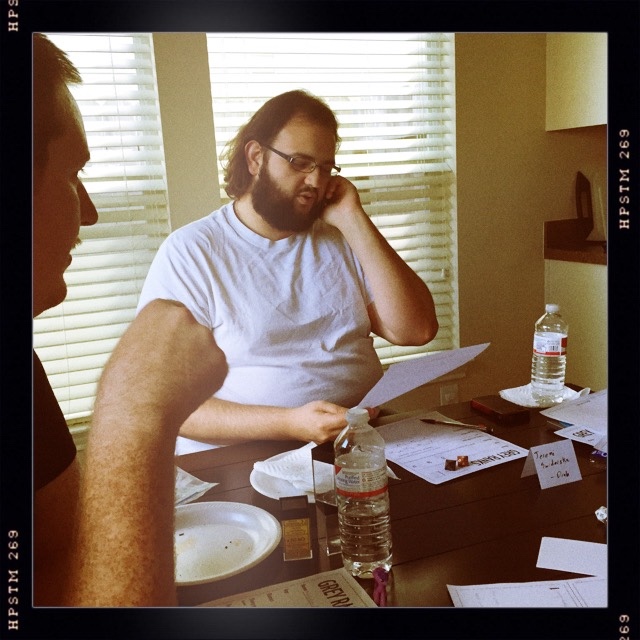
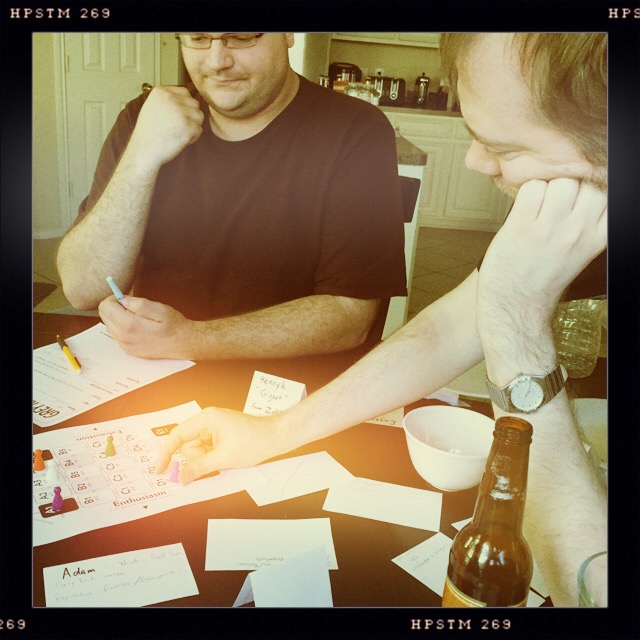
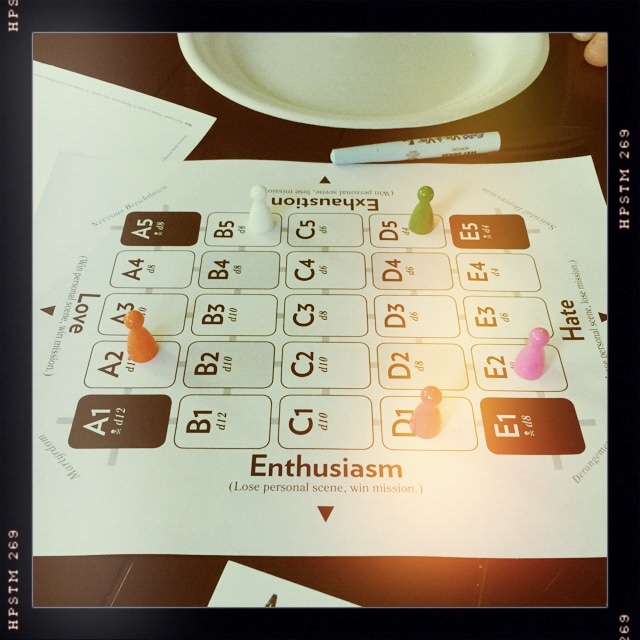
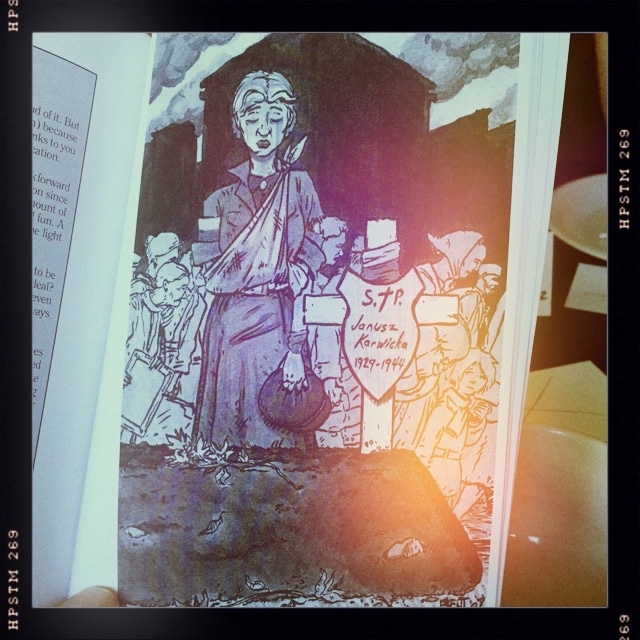

Tomorrow for Story Game Sunday, we are playing Jason Morningstar’s Grey Ranks.
Tomorrow for Story Game Sunday, we are playing Jason Morningstar’s Grey Ranks. In this one, you play young Polish partisans before, during, and after the failed uprising against the Germans in 1944.
Some pics from our Friday Anthology game last night.
Some pics from our Friday Anthology game last night. The adventure took an unexpected turn, which I found pretty exciting, as it forced me to really think on my feet.
There was also some really good character progression last night. Things that had been bugging me were discussed and we started to put a fine point on backstory elements that had only been mentioned vaguely before.
Thanks to everyone who came out: Ferrell Riley Kristen D Scott Owen Kristina Vansickle Marcus Centurian Jeff Burke and Gary Wilson.
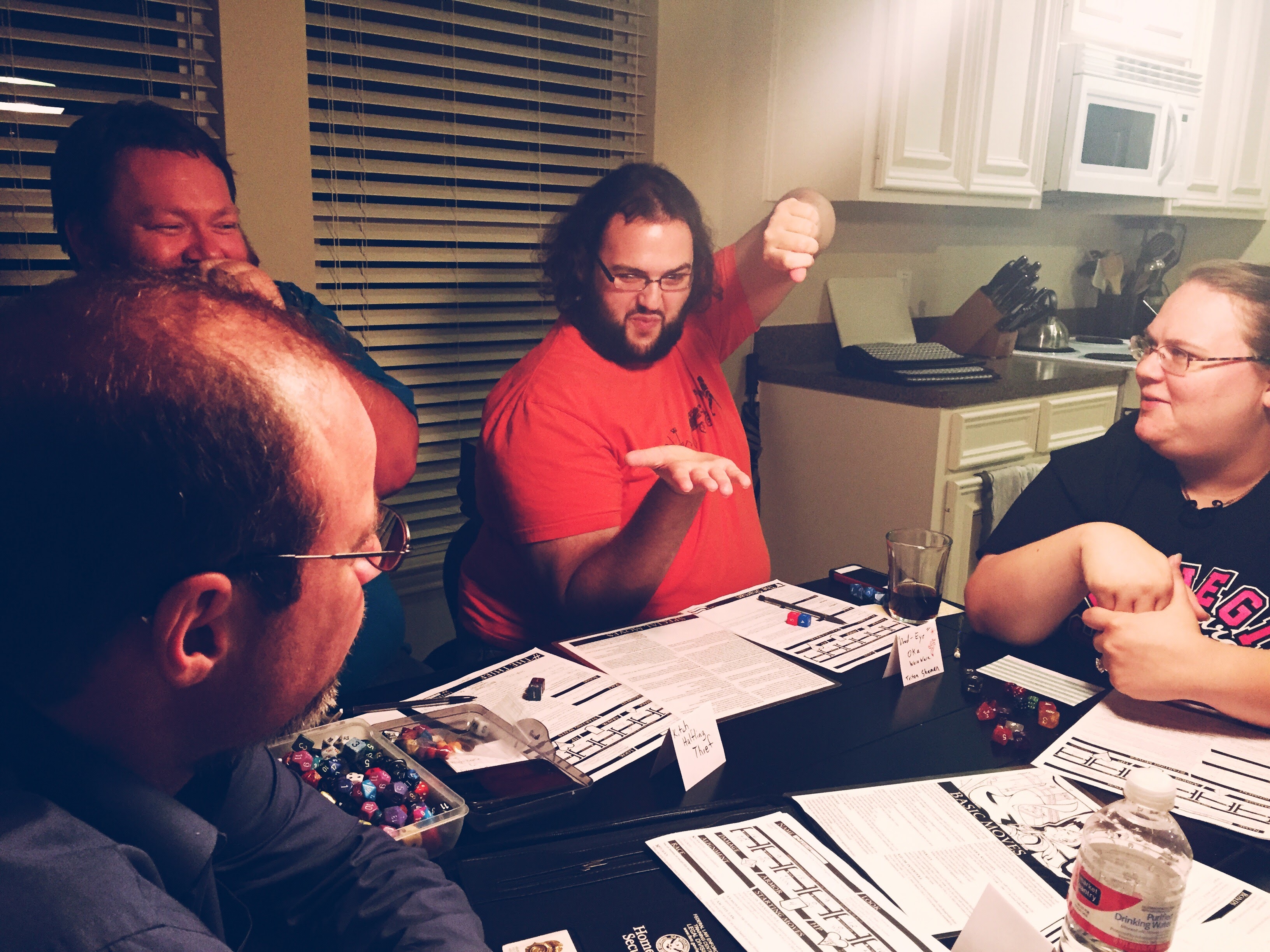
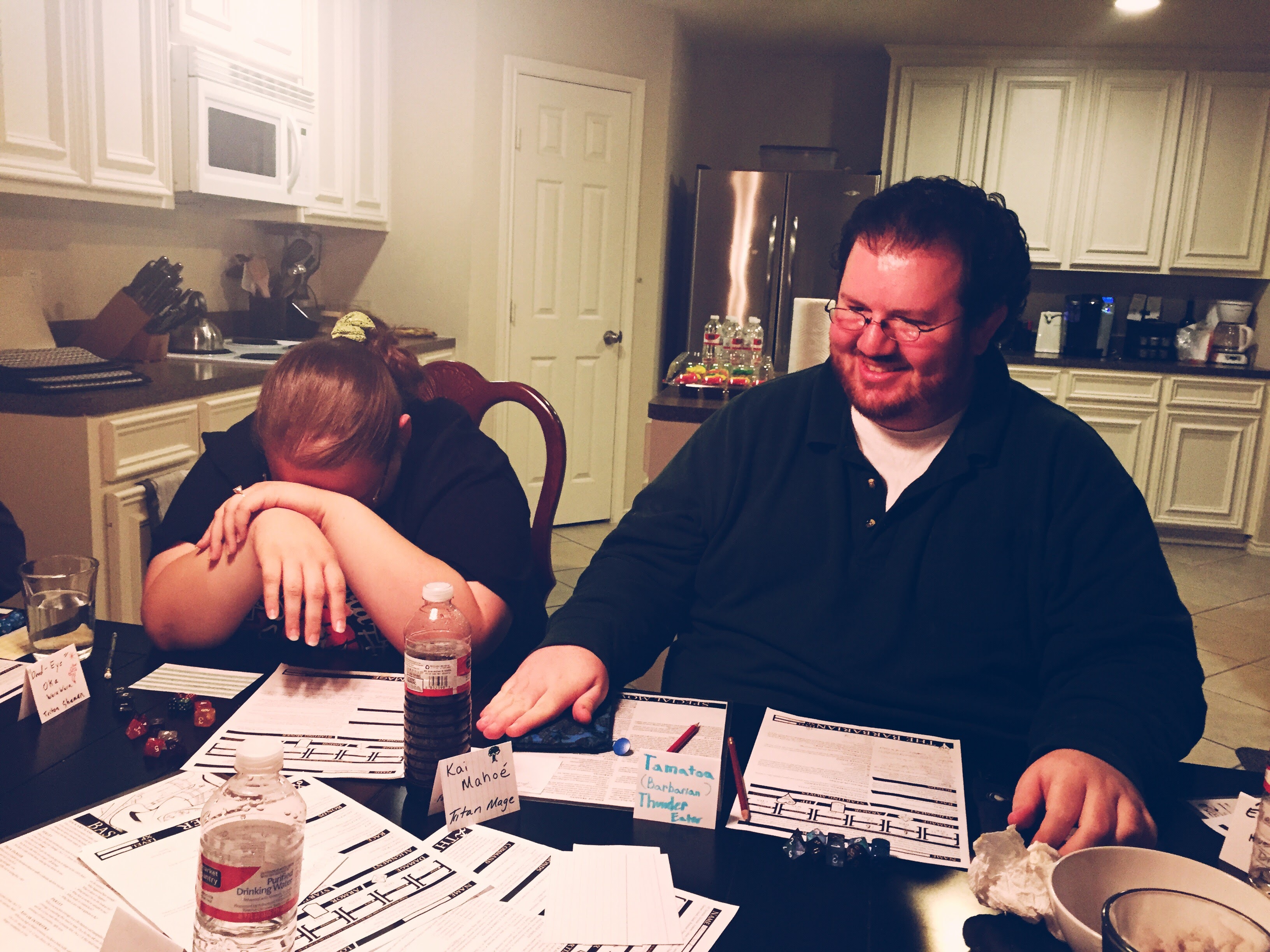
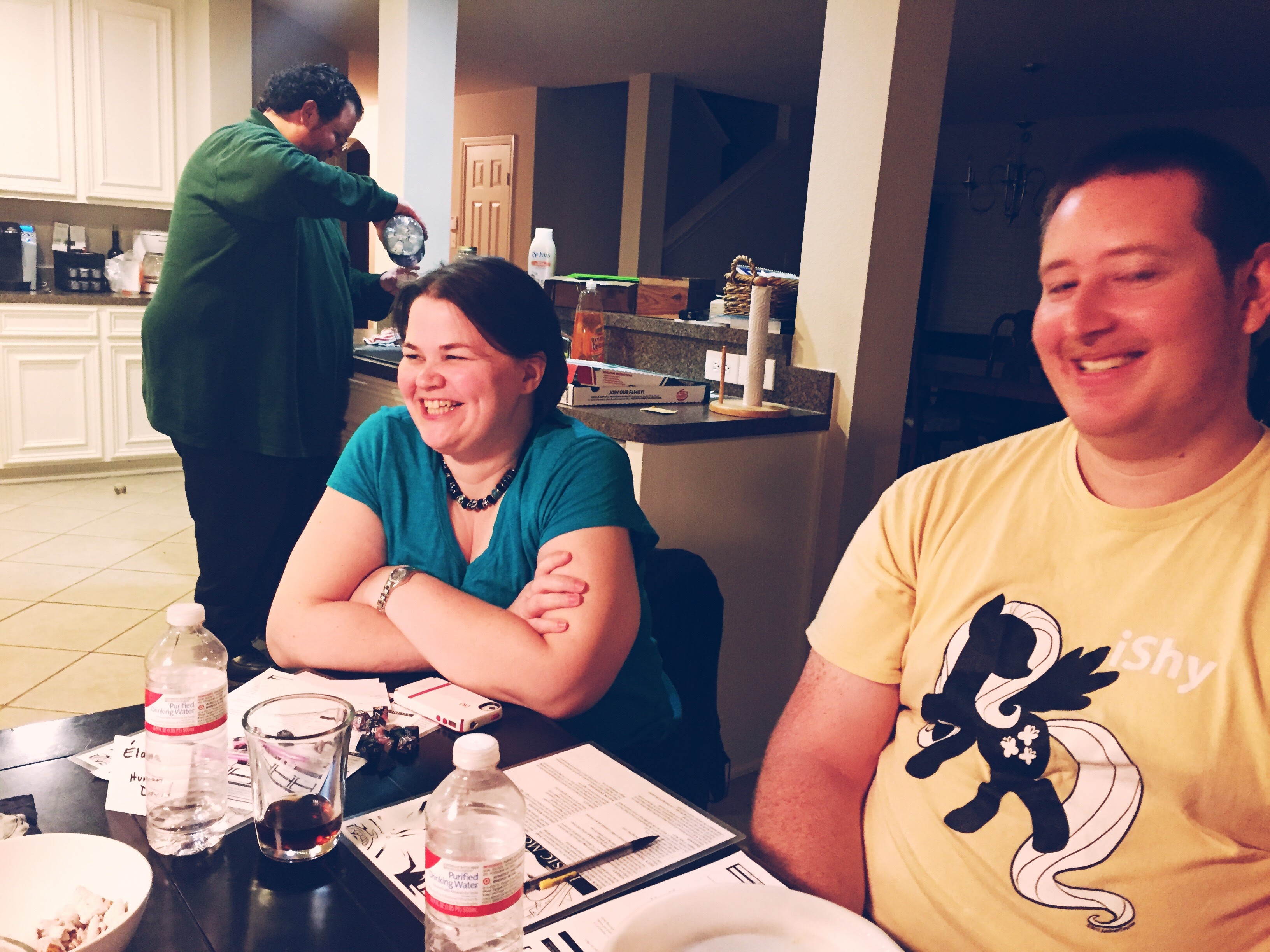

Some pics from Wednesday One-Shots. We played Monsterhearts and Goblin Quest.
Some pics from Wednesday One-Shots. We played Monsterhearts and Goblin Quest.
Thanks to everyone who came out: Daniel Lewis David LaFreniere Russell Benner parrish warren James Niu Kristen D Scott Owen Gary Wilson James Melott and Ferrell Riley.
